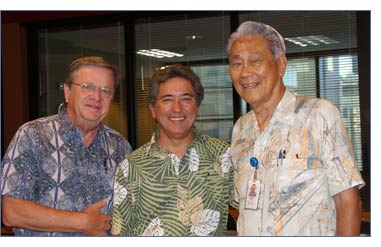Chronicled in this section of the CH2M HILL Alumni History are many of the ways in which the firm grew. At first our growth was primarily in the form of new offices located in major cities that appeared to present an opportunity for growth. In addition, subsidiary companies, usually wholly owned by the firm were created to provide an opportunity for the firm to expand into some new field. Mergers and acquisitions formed the third way in which the firm grew. All of these growth mechanisms are chronicled in this section of the history.
This is a section that is still quite incomplete and would greatly benefit from input from knowledgeable alumni who can assist with submitting information relating to specific expansions that are not now present in this history. Please contact CHAA_History if you can help.
Expansion Offices
The road to success is fraught with peril but ultimately marked by hard-won victories! CH2M HILL has experienced both ends of this journey! During hard-scrabble times, the staff grunted and groaned but invariably bent their backs to turn near-tragedies into ultimate victory. That is the kind of stuff that most start-up companies still struggle to instill into their ventures today, but CH2M HILL had to invent the unique solutions to such problems as they were encountered during lean times in order to grow and survive in a highly competitive field during its infancy years.
Accessibility to their services was a major issue as CH2M HILL’s reputation spread throughout the western states, primarily Oregon, Washington and Idaho. Each of these areas were, on one hand, prime targets for CH2M HILL business ventures, and secondly, were clamoring for the attention of reliable, responsible firms to supply the engineering services required by their burgeoning populations and local business ventures. This need was certainly exacerbated by WW II during which infrastructure in the U.S. was pretty much ignored in favor of the war effort. CH2M HILL responded to the call by opening new offices in Boise, Idaho, Seattle, Washington; and Portland, Oregon. That was the start of the subsequent growth process that CH2M HILL experienced, and became an accomplished master of in later years.
By now, the size and reputation of the budding organization had drawn considerable public attention and a requirement for easy recognition by the public became more and more apparent, so the CH2M monogram was created and adopted as the official logo. In subsequent years, this monogram was replaced by others, especially during the periods when the acquisition of Black Crow & Eidsness and Clair A. Hill & Associates required dual identification for publicity purposes (Logos) (PDF).
Now, with four offices running full tilt toward a perilous future, CH2M HILL jousted with the windmills of competition, regulations, and constantly improving sciences in their engineering portfolios. While growth was inevitable, controlled growth was the key to a successful future. President Jim Howland, by nature a conservative individual, made sure that CH2M HILL’s ability to maintain its forward march was constantly in lockstep with all of the requirements of staffing, capitalization, and business potential of new area locations.
As part of this historical record, the story of how CH2M HILL started its expansion into the far distant corners of the world is described in the mini-histories of how these and a few other initial expansion offices were conceived, staffed and supported. Subsequent offices, which now number nearly 800, utilized the lessons learned in these initial ventures in order to become successful components of the CH2M HILL we see today.
On May 27, 1987, the Sherwin-Williams Distribution Center, located directly on top of the Miami Well Field, and containing 1.5M gallons of paints and solvents, caught fire. The City of Dayton retained CH2M HILL to represent its interests during the subsequent Sherwin-Williams investigation and cleanup. This led to a significant amount of business for CH2M HILL’s Water and Environmental groups in southwest Ohio for the City of Dayton and other clients for many years.
In 1993, CH2M HILL began environmental work at Wright-Patterson AFB to perform remedial investigations, feasibility studies, and design work to help clean up legacy environmental contamination at the base.
In 1994, the firm established a Transportation Business Group presence in Ohio. After initially supporting ongoing aviation projects at the Dayton International Airport, and roadway and bridge projects for the Ohio Turnpike Commission and local agencies, CH2M HILL landed its first major project for the Ohio Department of Transportation: the study, design, and services during construction for the reconstruction of the I-70/I-75 Interchange, in Dayton. Over the past 28 years, the firm has had a hand in many significant transportation projects throughout the state.
During that period, the firm continued its growth in Ohio in all business areas:
1995 — Opened a new Cincinnati office to serve the Cincinnati Water Works, Cincinnati Metropolitan Sewerage District, and the Northern Kentucky Water District. See EXPANSIONS, Cincinnati, Ohio for more details.
1995 – Opened a new Cleveland office to serve the Northeast Ohio Regional Sewer District
1997 – Industrial Design Corporation (IDC) secured a contract to serve as construction manager for al facilities management and capital improvements at the GE Aviation Plant near Cincinnati
2000 — Industrial Parts and Equipment (IPE) was created to source parts used in jet engine repairs by GE
2001 — Opened a new Columbus office to expand transportation services in Central Ohio
2002 – Operations Management International (OMI) secured an operations contract for the suburban Clermont County wastewater utility
2003 – CH2M HILL acquired Lockwood Green, adding about 100 staff in the Cincinnati area and expanding the firm’s client base to major chemical and pharmaceutical companies in Cincinnati (P&G, BASF) and Indianapolis (Eli Lilly)
2005 — Acquired BBS Engineers, adding 135 Water business group staff and capabilities in Columbus and Cincinnati
2005-2017 — Dayton office fluctuated in size as we supported local, national and international projects, until it closed in 2017; staff relocated to the Cincinnati and Columbus offices, and work from home
2018 – Jacobs acquired CH2M and today the firm has a total staff count of about 500 in Ohio (Cleveland, Columbus, Cincinnati), including 115 legacy CH2M staff
Steve Wanders
Cumming, GA
CH2M HILL 1980-2014
(Dayton office 1994-2007)
Boise, Idaho
(as recalled by Gene Suhr)
A major step was taken toward becoming a multi-office organization with the opening of a second office in Boise, Idaho in August with Earl C. Reynolds, Jr. as the Engineer in Charge. The decision to create an office in Boise rather than, say, in the immediate Northwest neighborhood was influenced by several very important factors. First, Reynolds, through his family, had important connections in Boise. Second, CH2M was bidding on a very large and important project in the Boise area and the likelihood of winning a contract was very high. Servicing such an important contract required strong local presence; hence the need for a Boise office was a logical decision. And finally, it did not take a great deal of business development research to discover that the general area that could be serviced by a Boise office was very large and appeared to be much in need of just those services that CH2M could provide.
This was the first of our expansion offices. Started in 1950, it remains to this day the oldest of our many offices other than Corvallis. With the advent of the Boise office came a need to be able to identify which projects “belonged” to which office. The solution was to use the airline designator for the particular city in which the office resided, Hence, Boise became BOI and Corvallis became CVO. Later, when the airline codes sometimes weren’t suitable (example IAD—Dulles International for Washington DC), a three-letter designator better suited to our needs—like WDC—was coined and used. Read More…
CH2M HILL Seattle – The Early Days
As Remembered by Jim Poirot and others – 2006
Why Seattle?
Although I was not involved in the first discussions about expansion, various partners commented to me that now that the Boise office was stable and expanding that another office was possible. Earl Reynolds had developed the Boise market and others from Corvallis had been transferred to Boise to help with the marketing and smaller projects. The larger projects were accomplished in Corvallis.
Portland was also under discussion, but Ralph Roderick had been following the Seattle sewerage program that was just beginning a drastic expansion. The State of Washington had recently authorized the formation of regional sewerage agencies and a Seattle attorney and statesman had spearheaded the formation of a regional sewage district to solve the pollution in the 25-mile-long Lake Washington. Although the City of Seattle formed most of the western shoreline, there were numerous other communities all around its shores. All had raw sewerage discharging into Lake Washington, which created unsafe conditions and was deteriorating the lake.
This resulted in the formation of the Seattle Metropolitan Sewerage District. An engineering study was completed which recommended two new sewage treatment plants, many pump stations and numerous interceptor sewers. The engineering joint venture, know as Metro Engineers, included Brown & Caldwell, Hill, Ingman & Chase, R.W. Beck and others. Most of the engineering was to be accomplished by Metro Engineers along with a smaller district staff.
Ralph Roderick and Holly Cornell recognized that there would be additional work from Seattle Metro and that the surrounding communities would all need more engineering to develop new and expanded sewer systems. This justified an early move to develop the relationships and the selection of CH2M for some of the work.
Holly Cornell had been responsible for eastern Washington along with the Oregon shores of the Columbia River east of Portland. This included ongoing work at Hood River, The Dalles, Pendleton, Walla Walla, Milton Freewater, Pasco, Kennewick and Richland. Holly also was responsible for work with the U.S. Army Corps of Engineers headquartered at Walla Walla, which resulted in ongoing work in relocating a railroad behind the John Day Dam, relocation of the small towns of Arlington and Boardman and other assignments. Holly had also made contacts further west at Yakima and Wenatchee.
With new dams on the Columbia, the states authorized the establishment of port districts and this led to Jim Howland investigating engineering work for the ports. He and Jim Poirot landed a small study for the Port of Umatilla to determine the development plan for port properties and to recommend the first stage of development. Jim Poirot was the project engineer, and the study led to the design and construction of a dock, railroad, water system for fire fighting and later a marina.
Also, Holly made a contact at the City of Normandy Park by the Seattle Tacoma Airport. There had been controversy over whether the city should have its own sewerage system or be part of the South Suburban Sewer District. This resulted in a study for the city which was about to begin.
Opening Team
The decision was made that Holly Cornell should take eastern Washington and Oregon clients with him to Seattle. Since Jim Poirot had been working with Holly from about 1958 on most of the work, Jim was invited to move to Seattle, too. The Normandy Park study would be accomplished in Seattle and Jim would be the project engineer with Holly the partner in charge.
Holly felt there should be a third person selected to move who knew the Corvallis procedures, drafting standards and reproduction system. Oscar Frial was selected because he was working on Jim Poirot’s projects, he was very capable and he desired to transfer. Oscar was a University of Oregon graduate in Architecture but had worked part time in Corvallis at CH2M and was now full time. He was a foreign student from the Philippines and found there was a strong Philippine community in Seattle.
Office Location
Holly analyzed possible office locations including downtown Seattle and nearby cities. He felt that it was important to be working closely with others involved in Seattle Metro and related projects such as financial firms that marketed city bond issues, city attorneys and other engineering firms. This led to his decision to locate downtown. The Logan Building on Union Street and 5th Avenue was selected and space was rented on the sixth floor. There the Seattle office began in 1960. The office later moved to the eighth floor and expanded numerous times. On the sixth floor Holly had an office and there was one large room for engineers and draftsmen. At the beginning, there was one steel desk with a Formica top, a table and a shelf along the window in the large room. Finally there were five desks along the window side and two drafting tables on the inside wall along with a Freidan calculator and a rolled thin paper copy machine.
Holly then contacted Manpower to select and hire the fourth member of the team, a receptionist/ secretary. A native of north Seattle, Leslie lived near the University of Washington. She had recently returned from attending Vassar College in the East and had strong recommendations.
This completed the team and July 1, 1960 was set for the opening date. Holly and Jim Poirot selected homes in north King County outside of Seattle and Oscar moved to Seattle near friends from the Philippines.
First Projects
The Normandy Park sewerage study proceeded but involved previous controversies from the residents who did not want to pay the assessments and monthly costs for a new treatment plant. They argued that their septic tanks had been very expensive to build and some had sea shells imported to enhance the effluent percolation into the soils. The sewerage treatment plant controversy included whether it should be owned and operated by the city or the Southwest Suburban Sewerage District. The drainage basin included areas outside the city and a large portion of the capacity would be for the district. After litigation and numerous public meetings, the existence of E-coli in the roadside ditches was not tolerable and a final decision was made to proceed with the design of a sewerage system. The plant would be a responsibility of the district. Holly Cornell’s impressive explanations of the need, the logic and the costs at the public meetings were vital to public acceptance and his convincing expert testimony at the trials was crucial to a favorable decision to proceed.
The Normandy Park sewer design was accomplished in Corvallis with Lyle Hassebroek assigned to be the project engineer. Jim Poirot was the project manager and initially continued negotiations with the district. Lyle then moved to Normandy Park to be the resident engineer after the construction began. This was the first utility system for the city and Lyle worked continuously with the city manager, John Nicholson, to bring about the first city-wide sewerage system. Lyle then moved into the Seattle office to manage the Water and Waste Water Department of the rapidly expanding office.
The Richland water system study was also moved to Seattle and accomplished by Jim Poirot and a new engineer straight from England, Barry Barnes. Holly Cornell continued as the partner in charge, working extensively with Murray Fuller, City Manager. This study led to a new water treatment plant designed by Russ Culp in Corvallis, a prestressed concrete water storage tank designed by Dale King in Corvallis and a detailed analysis of the existing wells by Barry Barnes.
Work at Kennewick was from the City Engineer, Mar Winegar, and consisted of water pipelines and a new Raney well system along the Columbia River. The Pasco work was the continuing startup of a new water treatment plant. George Fisher was the city engineer and later joined CH2M in Seattle until his retirement.
The Port of Umatilla work continued partially from Seattle and the marina by Ken Stewart in Corvallis. This led to studies for the Port of Benton in Richland. A new dock on the Columbia was designed and the Port acquired property at Prosser, WA which was developed for industrial use. CH2M became the designers (designed in Corvallis by Wayne Phillips in coordination with the Walcott brothers in New York who were the owners of the new Seneca Corporation) of the first grape juice plant in the western states by Seneca from New York and a sewage lagoon was designed at Prosser for the wastes.
Other initial projects from Seattle were a sewerage study for Pendleton, revisions to the Pendleton airport, a prestressed concrete water tank for Wenatchee and the initial studies for a sewerage treatment plant in Yakima.
In Puget Sound the early work was for a sewerage investigation at Anacortes, water system studies at Centralia and continuous marketing for future work. After an initial study of the Port Angeles sewerage system a new treatment plant and outfall was designed and constructed with Lyle Hassebroek the project manager with the help of Jerry Boyle and Lowell Tuttle, outfall design by Phil Hall and Dave Peterson and Norm Ward designing the sewage treatment plant. A close relationship was developed with the Port Angeles City Manager, Don Herrman. A similar relationship developed with Ed Henken, Bellingham City Engineer and later Whatcom County Public Works Director, which led to early sewerage projects for Bellingham and in the 1970s, a “famous” ferry dock project for Whatcom County having serious problems. Recently, March 2006, I had a long visit with Ed Henken who is now retired, and he reviewed many of our projects when we worked with him. He described the ferry dock in detail and said he was proud to have had CH2M as engineers and, although we had our share of difficulties, we did all the right things and the final project was very acceptable.
Unique Project Stories
Pakistan Grain Elevator:
We hired a foreign student at WSU, Farid Ahsanuddin, from Pakistan who had been recommended to Holly Cornell by his structural engineering professor at Washington State University. I worked with Farid to keep him busy, flew him in my airplane to a spring OSU football game, took him on a tour of the Corvallis office and encouraged him to think of CH2M as a career. We hired Farid for two years after he graduated from WSU. We then hired Bob Hahn in about 1962, a structural engineering consultant in Spokane, who had specialized in grain elevators. Bob Hahn moved to Seattle and had Farid Ahsanuddin helping him.
Farid’s relative, an uncle or cousin, visited Seattle and I took them to lunch at the Washington Athletic Club. He was describing the new government-funded program to have farmers construct small steel grain elevators among the farms so that a group of farmers could have stored grain to last through the poor harvest years. This led to discussions about Bob Hahn designing a typical elevator and having Farid help him. The idea was for Farid’s relative to handle the Pakistan program and Farid would return to Pakistan to set up a CH2M office and manage the installation of the first and hopefully many more grain elevators.
Dr. Herschel Jones had joined CH2M through the Zinder and Associates acquisition in the mid 1960s and had a US AID contract in Thailand to study the economics of a nation-wide power transmission system. Since Dr. Jones had traveled to that region of the world, we asked him for his advice about CH2M operating in Pakistan. He supported the plan and volunteered to go with Farid to help set it up. After further discussions, it was decided that Holly would be the best to go with Farid, which he did.
As the first design was being fabricated and installed, it was found that there was no way for CH2M to be conveniently paid in U.S. currency, but bartering goods could be arranged such as carpets. Carpets were accepted and sent to the U.S. with no organized market for CH2M to barter the carpets for cash. Employees purchased some and the firm used some. Also, the elevator project did not progress in Pakistan and Farid set up his own consulting engineering business in Lahore, Pakistan which became one of the most thriving engineering businesses in Pakistan. Farid remains a good friend, we communicate continuously, I have visited him in Lahore and he and his family have stayed with us in the U.S.
Valdez, Alaska
The Seattle office in the mid and late 1960s had developed a number of major very profitable projects. One was the design of the new town of Valdez, Alaska in the spring of 1964 after the 9.2 earthquake demolished the old town. This resulted from a phone call to me from Warren George, the Chief of Engineering, Alaska District whom I had worked for as a Lieutenant in the U.S. Army Corps of Engineers. Holly was on vacation and they wanted me or someone to be in Anchorage the next day to start negotiating design contracts immediately for construction starting in a few weeks. Jim Howland asked me to proceed which I did and, over the next few days, negotiated contracts for streets, storm sewers, water supply and distribution, domestic sewers and treatment, electrical power and general coordination with other consultants. This led to all work being assigned to Corvallis except the electrical system and the storm sewers, which were sub-contracted to Philleo Engineering in Fairbanks.
Because of the requirement to complete the street and underground utility construction by the fall freeze-up, I traveled to Anchorage and occasionally to Valdez weekly, and often twice per week. Some trips were to Anchorage in the morning and back that night on the “red-eye.” I often flew with Bill Shannon of Shannon & Wilson and he became a good friend. Shannon & Wilson was the firm selected to accomplish the geotechnical work on the new site five miles up the North shore from the old town. The work was profitable and we declined an offer of additional fees if needed on the STP. Construction was essentially complete by freeze-up in the fall of 1964. (See available article published in “Civil Engineering.”)
McNeil Island Federal Penitentiary
With Lyle Hassebroek serving as project manager, a study and design was completed for waist treatment plants for the prison and the farm facilities on McNeil Island in Puget Sound. Assisting Lyle were Phil Hall, Dave Peterson and Jerry Boyle. Numerous “interesting” events occurred along the way such as searching in the yards and buildings for the routing of sewer lines that were unknown, eating in the VIP dining room and being served by convicted murderers, and having prisoners as members of the design and drafting team. One draftsman had developed into an excellent India ink draftsman. Upon being released from prison CH2M was contacted to hire him during his transition stage which we did.
The Marketing Role of Engineering Associations
Holly had been active in the American Society of Civil Engineers and in the Consulting Engineers Council in Oregon. I had been involved in the ASCE Student Chapter at OSU by judging student contests and attending Oregon Section meetings. We both immediately joined the Seattle ASCE Section and the Consulting Engineers of Washington. Holly was also active in the local American Water Works Association where Fred Merryfield had just completed his role as the National AWWA President. The Water Pollution Control Association meetings in Washington were also attended.
Holly soon became the Seattle Section, ASCE President and I became the Membership Chairman. Holly also became the President of the consulting Engineers of Washington and I served on the Public Relations Committee. In ASCE I served on the 1967 National Convention Local Committee as Budget Chairman and in 1971 served as General Chairman of the combined National ASCE & ASME Transportation Convention. In the ’70s I also served as president of ASCE Seattle and CEC Washington.
The above activity directly led to numerous relationships that resulted in small then larger projects. Some of the many projects primarily resulting from these contacts are: I met Paul Wyatrack and Elwood Ott from the Seattle Engineering Department which led to the Seattle Storm Sewer separation assignment. I also first met Tom Gibbs, Executive Director of Seattle Metro at an ASCE meeting and later at Water Pollution Control meetings. This led to Tom searching for a unique assignment for CH2M that could not be accomplished by Metro Engineers. The first project was an economics study, managed by Dr. Herschel Jones, of the decisions that led to the current configuration of pump stations and the two new sewer treatment plants in the Seattle area. This led to the major studies described herein. Holly knew the Chief Engineer of the Seattle Water Department, Roy Morse. As he retired, he introduced us to his replacement and this led to continuous assignments for the Water Department, including rate studies and pipeline investigations. These relationships also led to Seattle City Light hiring CH2M to study the environmental impacts from a proposed Copper Creek hydroelectric plant on the Skagit River and to study the environmental impacts of raising the existing Ross Dam on the Skagit River.
The 1971 ASCE-ASME convention committee meet often for over a year and weekly for the last two months. The Technical Program chairman on the committee was Frank Jenes who was assistant chief engineer at the Port of Seattle who introduced me to Vern Lundgren, the chief engineer. They both helped us propose on the first container terminal for the Port of Seattle in the early ’70s. Dick Foster was the project manager and this led to many other Port assignments.
These relationships resulted in lasting friendships and in hiring some of the valuable engineers from the client staffs. The relationships were built by attending evening and weekend meetings continuously and in volunteering to lead society events. Attending sports events together also helped considerably. Without these professional society relationships, the progress of the Seattle office would have been at a much slower pace and maybe some of the larger projects would have never been obtained.
University Relations
Pro-active University relationship building was a broadening goal during the ’60s and continued throughout the next decades. The original concept of locating in Corvallis by the founders was to be near a major engineering university, its staff, its students and its libraries. When the Seattle office was opened this concept continued by contracting in 1961 with two environmental engineering professors (Bob Seabloom and Bob Sylvester), to assist in studying sewerage outfall alternatives in Normandy Park near Seattle. Prof. Bob Seabloom and I spent a long Saturday on a small boat dropping numbered floats in Puget Sound off the Normandy Park beach and triangulating their locations to determine currents at various tide levels. We continued contracting with UW and starting in the early ’70s Prof. Seabloom brought his freshman orientation classes to our office where I would tell them about CH2M and give them office tours. We also gave lectures at UW and later at Seattle University, which resulted in top students like Gary Graham and Jerry Boyle applying for employment after some of my lectures.
First Changing of the Guard
In 1966, there was a strong team developed for the young office (see 1966 Organization Chart), with Carl Ryden and Jim Poirot as division managers and Barry Barns, Lyle Hassebroek, Bill Johnson as department managers. After six years, a decision was made to reorganize the Seattle office. Holly Cornell took on a special assignment to develop new methods and procedures for project performance, and the application of technological advances in communications, data handling and management systems to engineering techniques. This full-time assignment was accomplished in Seattle. Jim Poirot was assigned as Seattle Office Manager in 1967 and Carl Ryden was assigned the responsibility to concentrate on industrial projects in Washington and Alaska in addition to his other mechanical and electrical engineering duties and office wide assignments. By 1967 (see 1967 Organization Chart), Bill Watters had moved from Corvallis, Bob Hahn had been hired and the staff grew to a total of 35-40. In 1968, the team continued to expand and Dale King and Norm Ward moved from Corvallis to help manage the rapidly expanding list of projects.
Zinder Acquisition
Burke Hayes learned of the former group of Bonneville Power Agency associates who had formed a consulting firm in Seattle of economists and electrical engineers. Sol Schultz an electrical engineer and former Chief Engineer let it be known that the firm known as Zinder and Associates would like to be consolidated within a larger firm to better utilize their capabilities. The firm consisted of Dr. Herschel Jones, former Chief Economist of Bonneville Power, Sol Schultz, Harold Mozer, electrical engineer and specialist in rate studies, Lyle Dunston, electrical engineer, Sally Ruggles, secretary and Diane Kanning, bookkeeper and secretary. Other part time and contract associates in Seattle and Washington DC were available. They had ongoing contracts to help negotiate public utility rates for power utilities in the Northwest and for the group of aluminum industries in the Northwest. Contracts were also underway from the Federal Government. Holly Cornell negotiated the acquisition of the firm and decided to continue their operations in downtown Seattle in their present location until there was a consolidation of all Seattle CH2M operations in Bellevue in 1970. Sol Schultz worked part time for awhile and then retired and the others all became long term employees of CH2M, each with distinguished careers at CH2M HILL.
Rapid Growth
Washington State DOT
With the Federal Interstate Freeway program in full swing, Holly Cornell had established relationships with the Washington DOT. When the I-205 bypass around Vancouver, WA and Portland, OR became available to private firms, CH2M proposed in the mid 1960s and was successful in obtaining the preliminary and then final design contracts. A project office was established in Vancouver to work closely with the Washington State DOT local engineers. Bill Watters was moved to Seattle to provide the continuing contact with Assistant State DOT Engineer, Bill Bulley, and to supervise the Vancouver Staff. Gordon Elliott was moved to Vancouver from Boise where he had developed extensive credentials in Interstate Freeway designs. Maury Manning, Highway Engineering Technician, also moved from Boise to Vancouver. Other engineers hired for the Vancouver office included Otto Vydra, Dan Rawley, Mike DeLembo, and others.
Boeing 747 Plant
The 747 project was acquired after Holly Cornell worked closely with Bob Cole, VP of Boeing, to obtain smaller projects managed by Carl Ryden. In 1966, Boeing selected the Snohomish County Airport at Everett, Washington for the manufacturing facility of the new Boeing 747. The CH2M responsibilities included all the outside facilities across the bridge from the manufacturing building. They required all facilities to be completed by a fixed date when the first 747 rolled out of the assembly plant onto the finishing hard stands. Pan American Airways had been promised the first commercial 747 by 1970 after all flight tests and the FAA certification and approval had been obtained. Bill Waters led the design and construction management of all grading, concrete paving, storm sewers, sanitary sewers, domestic water lines, fueling tanks and underground fuel lines to multiple hardstands, underground lighting for 24-hour work on the airplanes, the foundation and all utilities for the two paint hangars and most of the vital railroad spur up Japanese Gulch to the plant. The schedule was demanding and the entire office was placed on extended work hours to meet the deadlines for the Boeing project and other projects in the office. The first 747 rolled out on September 30, 1968 and the first flight was February 9, 1969. The 1970 Pan Am date was met and all those involved in the airplane design and manufacturing, and the development of the facilities were nicknamed by Boeing as the “Incredibles.”
Lakewood Water District
As Water and Waste Water Department Manager, Lyle Hassebroek developed the study and later the design contracts for providing sewers in a large area south of Tacoma. Other firms had been actively marketing the District who had provided engineering services for the water system. Lyle’s experience in all the related components of the Normandy Park sewerage system and the developing CH2M reputation influenced some of the directors including an officer in the Weyerhaeuser Timber Corporation. This was a “percent of construction cost” contract that became very profitable. (During this period, it was quite normal to utilize the American Society of Civil Engineers graph showing the relationships of engineering services to the final construction cost.) This project was in the $1 million range.
Seattle Storm Sewer Separation Project
The Seattle Storm Sewer Separation project began in 1968 and included the first computerized drafting attempt in CH2M. The project was a large portion of the City of Seattle where combined storm sewers and sanitary sewers existed. This overloaded the West Point Sewage Treatment Plant. Holly had been studying the computerized future of the firm and became acquainted with an engineering professor at New York Polytechnic University. He had applied a computerized drafting process to the utilities in the streets of New York City. Holly invited him to visit us in Seattle and this led to Paul Wyatrack, who became the Chief Engineer, City of Seattle, agreeing to have us try the new CAD program on our portion of the storm sewer separation project. I had negotiated a fixed-price contract of over $900,000 with Paul and he agreed to let us incorporate the CAD work into the contract. Dale King moved to Seattle to direct the project with the team located in the Skinner Building across Union Street from the Logan Building.
McCord Air Force Base Runway Expansion
We had developed contracts on McCord AFB for an engine degreasing facility and had become well acquainted with Don Cardin on the AFB engineering staff. This led to a successful acquisition of a design contract for the main N-S runway reconstruction. The soils investigation was reduced but a design was developed. Bill Waters negotiated the contracts and Vaughn Sterling in Corvallis was the design project engineer. After the design was complete, Bill, Vaughn and Jim Poirot would not accept the reduced fees expected by the Air Force, partly because we were concerned about possible peat bogs under the runway that could not have been found in the limited soils investigation. We refused to enter a contract for Services during Construction which led to the Air Force selecting another firm. Both the construction contractor and the engineering firm selected terminated their contracts because of extreme overruns caused by unknown peat bogs under the runway found during construction. Others completed the work for the Air Force on a cost plus basis.
City of Lacey Sewer System
Lyle Hassebroek and others developed contracts to provide sewers for most of Lacey, a city north of Olympia, WA. This was developed following similar procedures as at the Lakewood Water District and was similar in size.
Metro Water Resources Management Study
Starting in about 1970 Seattle Metro, King County, the City of Seattle and others became again concerned about pollution in Lake Washington and related waterways. This led to the formation of a special council to study the long-range pollution impacts from future development of land in the watershed. It was decided to study the quantity and quality forecasts of the lakes and streams. By utilizing the capabilities of the recent merger with Clair A. Hill and the knowledge of CH2M waste treatment specialists, CH2M HILL proposed the development of an extensive watershed model for the entire watershed. This included modeling land runoff, streams, lakes and estuaries. Seattle Metro was designated the implementing agency and Tom Gibbs, Executive Director, managed the project development. With Gene Suhr as Project Manager, Don Russell Administrative Manager, Ron Ott and Wes Blood (from Clair A. Hill) the watershed model experts, CH2M HILL was awarded the project. Jim Poirot served as principal in charge and the project became a major effort leading to numerous new hires in the now Bellevue office. One hire was Dr. Larry Burke, a marine biologist, who directed the lake and stream sampling, testing and modeling. This required considerable sampling and testing and the development of the first marine biology laboratory. Constantine Zadorojny was hired to manage the lab. Ron Ott had recently completed his PhD at Stanford helping to develop the Stanford Watershed Model, and Wes Blood had done the same at the University of Utah. These new experts and the entire team worked out of the Seattle office over the next two to three years to complete the project.
King County Solid Waste Master Plan
As the Water Resource Management Study was developing, the same regional council identified other regional engineering studies needed. One was the disposal of solid wastes throughout King County. Previous studies over many decades had considered incineration and other possibilities. CH2M HILL now had new capability in solid wastes by the hiring of Al Grimm who had led regional solid waste studies in the Los Angeles area. Utilizing this new expertise and the existing geotechnical and landfill experience, CH2M HILL proposed and was successful in being awarded the study.
Port of Seattle First Container Terminal
Frank Jenes, Assistant Chief Engineer at the Port of Seattle had been on the 1971 ASCE-ASME National Transportation Convention committee chaired by Jim Poirot. When container terminals started to become the primary shipping mode, the port decided to build its first container terminal at Pier 47 on the Seattle waterfront. The cranes and other equipment had been selected but the dock, land storage, rail lines and other supporting facilities needed to be planned, designed and constructed. Frank Jenes called this to our attention and encouraged us to propose. With Dick Foster the project engineer because of his geotechnical expertise and a support team in Seattle and Corvallis, the project was awarded to CH2M HILL in the early 1970s. This led to other container terminal proposals and projects along the West Coast of the U.S.
Bellevue Move
With the rapid growth in projects and staff as discussed above, the downtown Seattle location in three buildings became inefficient and expensive. The employees were also not happy with the commute time and the parking costs. Floyd Hill, Administrative Manager, began to study the situation. He looked at possibilities north, south and east of Seattle as well as possible larger space in downtown Seattle. He also mapped where people lived. It was decided that if we made a final decision early enough, people who were considering a move would have time to select homes near the new location and others could start to research their individual options. After these considerations, a decision was made about one year in advance to move to Bellevue in 1970 and into a new building under construction. This was the ten-story Business Center Building and the tallest in Bellevue. Two floors were leased with storage space on the lower level. Later space on the lower level was also leased for the marine biology laboratory. Although two floors were more than needed, the rate of growth made it desirable to lease the extra space to prevent separated operations as existed in downtown Seattle.
People in the Sixties
Barry Barnes came directly from Birmingham, England to Seattle in the fall of 1960. He was looking for Fred Merryfield because of contacts in England when he had worked for the Birmingham Water Authority. After he talked with Holly and me, he asked if he could work for us in Seattle doing anything until he proved that he could accomplish engineering work and petition for a license. Barry was soon successful in his Professional Engineering Licensing petition and spent the rest of his career at CH2M HILL in Seattle.
Lyle Hassebroek had joined CH2M in Corvallis soon after graduation at the University of Wisconsin. As described above, he was the Project Engineer on the design of the Normandy Park sewer system and then moved to Normandy Park to serve as Resident Engineer during construction. From Normandy Park, he served in Seattle as Department Manager, Division Manager, Assistant Regional Manager, Regional Manager and Northwest District Manager until 1983 when he moved to Atlanta to become the Eastern District Manager. He retired in Denver as President of CH2M HILL, Inc.
Carl Ryden joined CH2M in 1952 in Corvallis. Being a mechanical engineer and participating in the design and development of the FlowMatcher with Burke Hayes, he was a needed asset in Seattle in the mid 1960s to help on the utility systems, but also to lead industrial work and electric utility systems consulting along with the Zinder staff. . Carl was the Project Manager for the initial Boeing projects with a primary project at the Boeing Kent facility. He developed a close relationship with the Boeing Facilities Engineer, Bill Farley, which was a primary factor leading to CH2M being selected to design the outside facilities at the new Boeing 747 plant at Everett.
Bill Waters, having specialized in earth projects (Olally Dam for Georgia Pacific Pulp and Paper mill, street projects and soil explorations) moved to Seattle to be the principal in charge of the first major interstate highway project for the State of Washington at Vancouver. Bill had become a partner in the firm a few years before the incorporation in 1966 and was the needed strength to carry the responsibility for the first major state freeway project for CH2M. With Gordon Elliott controlling the design very well in the Vancouver project office, Bill was then assigned to lead the tremendous challenge of designing and managing construction of outside facilities at the all-new Boeing 747 plant at Everett, Washington in the late sixties. Bill then served on numerous other firm-wide projects including in Trinidad as resident engineer for the Port of Spain water system construction.
Dale King had been working from Corvallis on Holly’s Eastern Washington projects including the design of pre-stressed concrete water storage tanks at Richland and Wenatchee. When the Seattle Storm Sewer Separation project was obtained (see description above), it was decided that a senior engineer should be the Project Engineer and located in Seattle. Dale was selected and he assembled a design team in the Skinner Building across Union Street from the Logan Building. Dale remained based in Seattle but took on other assignments including foreign projects such as the Cairo, Egypt water system project.
After working for Peter Kiewit Construction Company, Mike Anglea decided to pursue a different career and returned to Washington State University to obtain a Masters degree. Upon graduation he contacted CH2M in 1967 and joined the Seattle staff as an environmental engineer. Mike helped on water and sewerage studies and became involved in many of the Seattle projects such as the Boeing facilities, and sewerage systems for Stevenson, Lacey and Lakewood. Later, Mike moved to Milwaukee to assist in the development of the regional office and then the mega project for the Milwaukee sewerage system.
Bill Johnson transferred to the Seattle office from Boise and previously Corvallis. He arrived in Seattle in the mid sixties and lived in North Seattle near me. When I was not traveling, I picked him up to ride together into downtown Seattle. At times when our going home schedule did not mesh, he would take a long bus ride home. Bill helped on many projects and became a specialist in port planning. He was the Project Engineer on the Port of Benton (Richland, WA) dock, the Port of Wenatchee industrial park, the Port of Olympia airport and waterfront plan, the Port of Garfield, on the Snake River development plan and others. He worked on Indian reservation utility projects on the Olympic peninsula and in Eastern Washington. These were all projects that were valuable in starting of a new office and before the large contracts were obtained.
Bud Vanderaa came to interview CH2M from the University of Illinois in the early 1960s. I remember his interest in the surveying program at Illinois. After an evening at our house and a good discussion, an offer was made to him to work in Seattle and he accepted. Bud served in numerous roles of any type and was an early benefit to the growth of the Seattle office.
During a lunch hour in the mid 1960s a young engineer came in the office and asked to see the office manager. Holly Cornell was not there but I was eating my lunch and said I would talk to the visitor. Phil Hall came in and said he was researching employment opportunities. He said he had graduated from Michigan with an M.S. in Sanitary Engineering and had decided to move west. He had spent two years in the Peace Corps in Ecuador working on village water systems and wanted to work in the field of Sanitary Engineering. He obtained a job with the Navy civil engineers in Seattle as way to research private engineering firms and had concluded that CH2M was where he wanted to work. I thanked him and gave him encouragement and, as I recall, he went back to work after lunch at the Navy. When Holly returned, I explained the visit and recommended that we hire him, which we did. Phil worked on many projects including the North Pole, Alaska sewerage master plan and then transferred to San Francisco to replace Wayne Phillips as the Regional Manager. Phil went on to become the Southwest District Manager and then Chairman of the Board.
Gordon Elliot was a highway engineer from Wyoming who was hired in Boise to design a freeway project near Boise. He moved to the Vancouver, Washington office to be project d\engineer on the I-205 bypass freeway around Vancouver. He then moved to the Seattle office to manage other freeway and bridge projects. His career led to many impressive bridge projects in the West and award-winning projects in California.
Maury Manning was a key engineering technician on Boise state highway projects and new the highway drafting standards. Having completed the Boise assignments in the mid 1960s he transferred with Gordon Elliot to the Vancouver, WA office to prepare the preliminary and final designs for the I-205 bypass around Vancouver. Upon completing this work he moved into the Seattle office and soon managed all the engineering technician work in Seattle. He later moved to Corvallis to manage similar work there.
Other engineers added in Seattle in the 1960s and early 1970s included Don Russell, Dwight Curry, Fred Kern, Dave Peterson, Pete Wiedeman, Dick Foster, Gary Graham, Norm Ward, Mike Doleac, Collie Martin and Jerry Boyle. Floyd Hill was hired as Administrative Manager in the mid sixties. After the first year or two, Dianne Cummins was hired to be the receptionist, secretary, mail processing clerk, billing processor and to help with other technical assistant tasks. This soon led to an extensive overload and Janet Nyberg was hired to assist her. Janet had a special interest in calculations and with Bud Vanderaa’s help, she calculated most of the Normandy Park sewer assessments.
The First 20 Years
Developing a personnel base and a series of large contracts in the ’60s and ’70s provided the capability and qualifications for proposing, being selected and accomplishing the mega-projects in the ’80s and ’90s. My involvement does not provide the whole story by far, but some of the largest contracts in the ’60s were obtained in Seattle. The growth of the Seattle office during its first ten years was considered remarkable at the time. Starting in 1960 by moving three people from Corvallis, Holly Cornell, Jim Poirot and Oscar Frial (an architectural technician), the office grew to where the staff was located in three buildings in downtown Seattle by 1969 and was then consolidated into one building in Bellevue in 1970. When I became the Seattle regional manager in 1967, we were beginning to step up the pace and soon acquired the key large contracts that required considerable staff expansion (Seattle Storm Sewer Separation, Boeing 747 Plant and the SW Suburban Water District Sewer System).
The 1970s started off with a bang also. To my misfortune, I suffered a mild heart attack in 1970 which created a series of health issues for the rest of my career. Even so, the Seattle and Corvallis staff with some of the newly merged staff from Redding soon acquired major studies from Seattle Metro for creating computer models of the river basins through the lakes and metropolitan areas of Seattle. Also, a major solid waste disposal study was obtained from Seattle Metro. Other significant projects included the City of Lacey sewer system, the Yakima water treatment plant, the Port of Seattle first container terminal and numerous municipal and other projects.
John Mayo, former Yakima, WA City Engineer then Public Works Director, joined CH2M HILL in the mid 1970s and was given responsibility to further develop projects in eastern Washington. It was concluded that an eastern Washington office was needed to obtain many of the potential projects and to provide better service. John Mayo recommended an office in Spokane in 1977 with him being the office manager, but initially working also in Bellevue and from his home near Yakima. The Spokane office was started in downtown Spokane in an older building and consisted of two rooms, a receptionist/ secretary area and a manager’s office with work tables and desks. The initial operation used the adjacent company to answer the phones when John was gone and there was no other hired staff. Soon, new projects were obtained and a full time manager and staff were added.
When the firm was organized into districts in 1975, the Seattle Office became the headquarters for the Northwest District which included the states of Oregon, Washington, Alaska and Western Canada. Jim Poirot was appointed the NW District Manager. In 1978 when Jim also became the SW District Manager, Lyle Hassebroek became the Seattle Regional Manager. A Canadian office in Calgary was initiated with Steve Lackey moving to Calgary which soon became a permanent office. An office in Juneau, Alaska which came with the Clair A. Hill merger was soon closed and the Anchorage office was designated the permanent Alaskan office.
Trivia
Seattle Sonics First Season Tickets
After the second year (1968) of the Sonics in Seattle, the newly drafted players solicited the downtown businesses to buy season tickets. A forward named Bob Kauffman stopped by our office in the Logan Building and asked to speak to the manager. After I visited with him for a while and he explained the easy payment plan, we decided to buy four tickets for use in entertaining clients and other guests. The seats purchased then were in a very good location near mid court and up about ten rows. In 1978, the Sonics moved to the King Dome for a few years and the seats were also very good. The client use plan worked out very well and the tickets were in demand. Later in the mid-seventies, Raeda and I bought two additional tickets which we used continuously except when I traveled and then we gave them to clients or others in the firm. When I moved to Atlanta in 1980, these were renewed by the firm. They were also very good seats.
Lenny Wilkins’ Sister:
In the late ’70s when we were located in the Bell Field Office Park, CH2M HILL hired Lenny Wilkins’ sister as a receptionist. Lenny decided to move all his family to the Seattle area when he was coach and his sister applied at CH2M HILL. She was a very pleasant person and fun to have around. This only lasted about a year when it was mutually decided that she should not stay with us.
Seattle Seahawks First Season Tickets
In 1977 when the Kingdome was completed, the first pro football team, the Seattle Seahawks, began to announce the ticket sale plan. There was strong interest in CH2M HILL to purchase as many as allowed for clients and employee use. We placed an early order for the maximum which was 20. Raeda played tennis often with Fran Nordstrom on Mercer Island who was the wife of Bruce Nordstrom, one of the Seahawks owners. Fran said she could also help us buy tickets, so Raeda asked her to place another order for 20 tickets in case we were not successful through normal channels. The tickets were all sold out in two or three days. CH2M HILL was successful and we then had two orders of 20 each or a total of 40 tickets. We decided to buy all 40 and sell 20 each year to employees. Before long, the client demand was too great and after 3-4 years all 40 tickets were used to host client groups. Employees could only use them if they hosted clients. Those purchasing the tickets from CH2M HILL were not enamored by having to give up their tickets for client use.
Kingdome Construction
During the Kingdome construction, the original contractor, Drake Construction from Portland, stopped work because they claimed the lightweight concrete roof could not be constructed as designed. Litigation followed and Bob Hahn, structural engineer at CH2M HILL, was hired as an expert witness. Bob was an expert in concrete silo design for grain elevators, had considerable light weight concrete experience and served on professional concrete committees. The court concluded the Kingdome roof could be constructed as designed and Peter Kiewit was selected to complete the project.
Traveling
Although most of our traveling was by car, we often would fly on West Coast Airlines. I had ownership in a family airplane for over 40 years and also would occasionally fly my airplane to eastern Washington and Corvallis. Although the Alaska flights were jets and flew from SeaTac, West Coast Airlines flew out of Boeing field and mostly used DC 3 airplanes. A few F 27 pressurized airplanes were used but not to Yakima, Pasco and along the coast. The parking lot was just outside the door at Boeing Field and the airplanes were out the other side, making it very convenient compared to today. There was a morning flight to Pendleton that flew out of SeaTac by United Airlines and it was a Convair with propjet engines. It had a contract to take mail to Pendleton each day and also had many passenger seats. One morning I went to the flight and when I arrived at the plane, the crew had laid out a long red carpet at the bottom of the stairs that went about 50 feet from the airplane. At the top of the steps the entire crew of two pilots and one “Stewardess” were standing and saluting me. As I arrived at the top the Captain said “Welcome to your private flight to Pendleton”. I asked what this was all about and he said I was the only passenger and they had some champagne on board to celebrate. I thanked them and we had a very nice flight. Soon after, they cancelled further flights to Pendleton.
No I-5
Interstate 5 had not been constructed until about 1968. Holly and I lived near the north King County line and used Highway 99 which had many stop lights, as today, and many accidents. It normally took 45 minutes to go each way without accidents. When I was not traveling and on a normal schedule, I would pick up Bill Johnson who had transferred to Seattle from Boise and lived not far from me. One winter day when the snow was bad, our trip took from a very early start until noon. At one point we were going three blocks per hour.
First Christmas Party
All the staff went to Corvallis in 1960 for the first Christmas party. We all rode in the two firm cars, five in Holly’s car and six in the car I drove which was a Ford Falcon. The next year was a dinner in a small private room in the Washington Athletic Club which was around the corner on Sixth and Union.
Computers
Having only one electric calculator in 1967, we entered an agreement with Boeing Computer Services to try small computer programs. The data was entered on a Teletype machine in our office and the results were sent back on the Teletype. Accounting work was all accomplished in Corvallis on new IBM 1130 computers. Data was sent and entered on punch cards. Later, DEC 10 machines replaced the IBM 1130 computers in Corvallis.
The Teamsters and Mafia
While accomplishing the contract to develop a Solid Waste Plan for King County in 1971-73, Raeda and I purchased our first boat. It was a Cruise-a-Home that we purchased at Chris Craft on Lake Union. We moored it there for the first month or two and there was a beautiful boat moored under cover next to us. As our younger son, Ronald, was helping us wash our boat, the owner of the beautiful boat asked if Ron could be hired to help them wash and clean their boat. Ron was about 13 years old then and was a good worker. We said OK and Ron became quite friendly with them. One day the owner, Frank Matula, asked us to go to lunch with him and his wife which we did. While having lunch, Frank asked if we thought it would be all right if Ron went with them as a deck hand on trip into Canadian waters for a month or so. As we were talking, Raeda asked who all would be going on the trip. Frank said it would just be him and a good friend who turned out to be Joe Bonanno, one of the New York Mafia bosses. Raeda said we would have to think about when we were going on vacation and let him know. We later told him we would also be gone then.
The next day, I called a Rotarian friend who was an FBI agent and told him the story. He said to keep the conversation with him confidential and to not let Ron go anywhere with either of them, fully explaining why. Frank had told us that he was one of the three Trustees of the Teamsters Union and was in Seattle often having meetings with the unions including the possible new Teamster unionization of the Seattle and King County garbage truck operators.
During the same period, Ron was flying model airplanes with a neighbor boy on Mercer Island. One evening, the boy’s father invited me to go along with them to a field to fly the airplanes which I did. While there he explained that his family owned one of the two land fills used by the area garbage handlers and knew that CH2M HILL was studying the future disposal sites. He wanted to know about our views and how he could be assured their site would be given priority. He was aware of the Teamsters in the area trying to organize the truckers and wanted to be sure he was informed about our study. I explained that I was not the project manager and did not know much about the project. I also said all contacts should be made through the King County officials and that public meetings would be held to obtain all information applicable to the study.
My Rotary friend and I talked almost every day and he continually said not to mention our discussions with anyone else. He said they had followed Frank Matula every day and that it was obvious to him that they were exploring all possibilities to organize. After a few weeks, I was informed that Frank had moved his boat back to his home in San Diego and that they had not been successful in Seattle. I had moved our boat to a different marina and was not in contact any more with any of them. I had told Holly Cornell but no other person as requested by the FBI.
1965 Gold Cup Hydroplane Races
I had been going to Dr. Randy Pillow at the Virginia Mason Clinic for my annual aviation medical examination. Early in 1965, he asked if our engineering firm had the ability to make signs! There were about 20 committee boats required to work the hydroplane races on Lake Washington. 1965 was an important year for the annual Seattle hydroplane races because this was the Super Bowl of the annual race circuit. The winning city of the previous year hosted the next year Gold Cup Races and a Seattle boat had won in 1964. The 20 boats needed to have cloth signs noting that they were “Official Boats” so that others could be controlled and only these boats could be working the racing area.
I agreed to look into the possibility and talked Oscar Frial about ideas. Oscar was enthused and wanted to volunteer his time to make them. We decided to buy gold-colored oil cloth and paint brown letters on them. I proposed this to Dr. Pillow and he agreed. I was appointed to the Race Committee and attended the monthly then weekly meetings at the Seattle Yacht Club. Oscar and I received passes to the pit areas and at certain times to the official barge to observe the races and other activities. I still have my race committee badge and four or five of the annual 1965 hydroplane pins. (If anyone in Seattle wants these or knows of a use for them, I will give them to you.)
Ten-hour work days + Saturdays
A standard work schedule to include Saturdays had not been official since about 1953 in Corvallis. Because of the demanding schedule to meet the new Boeing 747 plant completions schedule, the entire Seattle office was placed on a standard extended hour schedule in 1968. Boeing required all facilities to be completed by a fixed date when the first 747 rolled out of the assembly plant onto the finishing hard stands. Bill Waters led the design and construction management of all grading, concrete paving, storm sewers, sanitary sewers, domestic water lines, fueling tanks and underground fuel lines to multiple hardstands, underground lighting for 24-hour work on the airplanes, the foundation and all utilities for the two paint hangars and most of the vital railroad spur into the plant. Realizing there was not enough time and staff, as manager of the Seattle office, I instituted a standard 10-hour work day with a dinner brake and an 8-hour Saturday schedule for the entire office for over a month near the end of the tight schedule. Our work met the Boeing deadlines in 1968, thanks to Bill’s constant attention.
Seattle 1962 World’s Fair
Construction was underway at the new Seattle Center for the coming World’s Fair when we arrived in 1960. The massive concrete pour for the foundation of the Space Needle, the Monorail piers, the Coliseum and many buildings were being constructed. Once completed in 1962, we had many visitors wanting to see us and also the World’s Fair. It was amazing how Corvallis people wanted to come to Seattle instead of us traveling to Corvallis. The city culture also changed because of certain shows at the fair. The Gracie Hanson Follies created a draw and resulted in a relaxed view of the “ladies of the street.” For awhile women were soliciting their services to men at all times of the day, even below our office on the streets. At least one followed a client into the Logan Building, up the elevator and to the entrance of our office “selling” her services all the way. Also, the city allowed topless waitresses for a few weeks until the protests caused the city to reverse its decision. Our hosting of clients and others made every day a long day. The fair created a new “signature” for Seattle – the Space Needle.
CH2M Flying Clubs
I had formed the Skylark Flying Club in Corvallis in 1956 and there were 15 original members. The club lasted for over 20 years and owned 7 different airplanes. In 1969, a flying club was formed in Seattle with 10 members. They purchased a used two-place airplane for training purposes, a Cessna 150, and parked it at the Renton airport. Some of the members were Art Storbo, Lyle Hassebroek, Mike Hamilton, and Raeda Poirot. Mike Hamilton was the first to obtain his private license and Raeda was the second. She had started her flying lessons in Fairbanks, Alaska with me in 1955, but stopped the lessons when the family came along.
Conclusions
These memories may be utilized as appropriate now, but will be further reviewed and expanded as others remember interesting details. As with all memories, there may be differences, but there will be agreement on most of the items described above. Any clear corrections will be noted in future drafts.
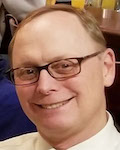 As Recalled by Nick Winnike
As Recalled by Nick Winnike
The prime target of the Cincinnati expansion was a nearly $2 billion wastewater system upgrade for Cincinnati Metropolitan Sewerage District (MSD) that had been identified in a facilities plan. However, the industrial wastewater group sought to expand market share with the chemical industry along the Ohio River basin and within a year of Nick’s arrival. Tim Harrison, also from the Milwaukee office, relocated to Cincinnati to pursue the industrial market. Shortly after Tim’s arrival, the chemical initiative was dropped; and Tim was assimilated into the industrial waste group in the Dayton office.
The first project secured by the Cincinnati office was the development of a franchise to be issued by the city to a vendor to install and operate a heating and cooling loop system to serve downtown office buildings. The Boise office supported that pursuit and met the key requirement to agree to have a senior technical resource in town for meetings with city staff on the day before Thanksgiving. The meeting did not materialize, but the franchising documents were prepared; and the local electric and gas utility was awarded the franchise.
The first Water project was won in early 1996 with a study to investigate the feasibility of completely automating a surface water treatment plant for the Northern Kentucky Water District (NKWD), a suburban water utility just across the Ohio River from Cincinnati. The project progressed into design with a very tight lump sum design budget. And the budget challenge was met by sending the design to the Toronto design center that was recently acquired with the purchase of the Gore & Storrie Canadian firm. The Canadian/U.S. exchange rate allowed a nearly 15 percent labor cost reduction. Over the next 20 years, CH would book over $7.5 million in fees on more than 20 projects for the utility including the design of granular-activated carbon and ultraviolet disinfection facilities at the two largest NKWD treatment plants.
About the time the Cincinnati office was opened, Operations Management International (OMI) secured a contract to operate the utilities at the GE aircraft engine campus in Cincinnati; but difficulty working with the union doomed that contract. Within less than 2 years, the Industrial Design Corporation (IDC) subsidiary secured a contract to serve as construction manager for all facilities management and capital improvements at the GE plant. Brad Spackman supervised that operation for decades. In the year 2000, IDC spun off another subsidiary, Industrial Parts and Equipment (IPE) whose mission was to source materials for the GE facility. IPE displaced a long-standing supplier to GE, and a high level of security was needed for the small office including lockable garbage dumpsters. The goal for IPE was to expand to be a sourcing agent for other clients and for CH2M Constructors Inc. design/build projects. But to date, the scope of IPE supply is largely limited to GE and first-tier service providers.
The CH staff moved into the IPE industrial warehouse facility in 2000. Within a year, we had won contracts with the four major water and wastewater utilities serving Cincinnati and the Northern KY suburban area. The office staff size had risen to four at one point before the move, but only two Water staff remained for the move. Having gained a general services contract with MSD and continued Task Orders for NKWD spurred growth of the office including Frank Duran to head up the business development activities.
Cincinnati is a hub for airport planning firms. About 2002, the Transportation group brought onboard John Von Woensel, who headed up an airport planning practice that grew to as many as eight staff over time. The group won planning projects in multiple countries but did not expand the practice beyond Cincinnati. About 10 years after its inception, the group staffing had dwindled; and the practice was closed out.
Cincinnati was in an expansion phase in the early 2000s, having won a major collection system planning study for MSD. Modeling staff were brought onboard; and Nancy Shultz, a senior technical consultant, relocated from Milwaukee to Cincinnati for a 2-year assignment to support the project and assist in growing the collection system planning group in the office. Susan Moisio, a current global practice director, was hired from MSD during that time and started as the practice leader in the office. In 2002, OMI again emerged in the area by securing an operations contract for the suburban Clermont County wastewater utility. A new county administration was elected shortly after the contract operations began and was opposed to outsourcing operation of county facilities. Both CH and EarthTech, which had been retained to operate the county water utility, agreed to early termination of the contracts before the initial 5-year contracts had expired. Todd Webster was hired from EarthTech after the termination of the contracts and has been managing the Fort Wayne office while supporting construction management (CM) services, Indiana operations, and the Louisville office.
Major growth occurred in December 2003 when CH acquired Lockwood Greene (LG), an industrial process engineering firm that boosted nearly 100 employees in Cincinnati and 2,500 globally. The acquisition of LG expanded the client base to the major chemical and pharmaceutical firms including Cincinnati-based Proctor and Gamble, BASF, and others. Following the acquisition, the CH staff continued to embrace the annual Cincinnati Multiple Sclerosis March of Dimes riverfront 5/10K family walk, a legacy LG activity. The CH and LG staff maintained separate offices for many years.
 Acquisition again spurred growth in 2005 when CH acquired BBS Engineers, a Columbus, Ohio,-based firm that had a strong history with MSD, Columbus Department of Power and Water (DPW), and the District of Columbia Water and Sewer Authority. The firm was small but powerful having a total staff of less than 140 employees, with 35 in Cincinnati, 100 in Columbus, and 4 in Washington, D.C. Employee owners of BBS included Don Cuthbert in Cincinnati and Paul Schlegel and Dennis Tinkler in Columbus. The Cincinnati Water staff moved into the BBS office. At this time, the firm had five separate offices in the Cincinnati area including the GE facility, IPE, the airport planning office, LG, and BBS offices.
Acquisition again spurred growth in 2005 when CH acquired BBS Engineers, a Columbus, Ohio,-based firm that had a strong history with MSD, Columbus Department of Power and Water (DPW), and the District of Columbia Water and Sewer Authority. The firm was small but powerful having a total staff of less than 140 employees, with 35 in Cincinnati, 100 in Columbus, and 4 in Washington, D.C. Employee owners of BBS included Don Cuthbert in Cincinnati and Paul Schlegel and Dennis Tinkler in Columbus. The Cincinnati Water staff moved into the BBS office. At this time, the firm had five separate offices in the Cincinnati area including the GE facility, IPE, the airport planning office, LG, and BBS offices.
Besides the thriving Industrial and Water practices in the office, CH established a water security practice in Cincinnati that aided both the United States Environmental Protection Agency (USEPA) and water utilities advance security processes and procedures following the 9-11-01 terrorist attacks. Even before the institution of the USEPA, Cincinnati had been the home of a federal Public Health Service research center advancing knowledge of drinking and wastewater treatment, collection, and distribution. CH secured a subcontract with CSRA to provide service to the USEPA that evolved into developing and running a full-scale pilot operation with Greater Cincinnati Water Works to investigate physical security systems and a sophisticated contaminant detection system that included a network of water quality sensors and a probabilistic computer model. The security work also morphed into Smart Water technology for wastewater combined sewer overflow (CSO) control using sensors and automated control structures.
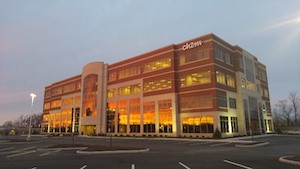 By 2010, all CH, BBS, and LG staff had consolidated into a single office of over 150 employees and a substantial contingent of contract employees supporting a major design-build project for a confidential client. In 2015, CM staff from the GE project were displaced by construction activities from the GE campus and moved into the final CH Cincinnati office pictured here that housed over 400 employees at its peak. The airport planning group had dispersed to other firms, but the Water practice grew substantially to offset the staffing count.
By 2010, all CH, BBS, and LG staff had consolidated into a single office of over 150 employees and a substantial contingent of contract employees supporting a major design-build project for a confidential client. In 2015, CM staff from the GE project were displaced by construction activities from the GE campus and moved into the final CH Cincinnati office pictured here that housed over 400 employees at its peak. The airport planning group had dispersed to other firms, but the Water practice grew substantially to offset the staffing count.
The Cincinnati office was an original sponsor and active participant in the Cincinnati area Water For People 5K and won the award for the most consulting firm participants in 2012. Shown here is the group of LG legacy and CH alums who participated.
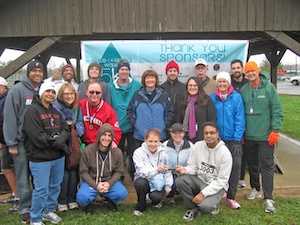 The Dayton office closed in 2017, and Transportation and Environmental staff were reassigned to the Cincinnati office. The purchase of CH by Jacobs in 2017 substantially swelled the ranks of Cincinnati employees to over 400 employees, and the CH staff moved into the Jacobs office in March 2018. Jacobs employed a substantial industrial process group and a small Water group in Cincinnati that meshed nicely with the CH staff capabilities. Today Jacobs is the largest engineering firm in the Cincinnati area according to the Cincinnati Business Courier. The office supports the traditional Water base along with industrial process design for chemical, pharmaceutical, and computer systems clients.
The Dayton office closed in 2017, and Transportation and Environmental staff were reassigned to the Cincinnati office. The purchase of CH by Jacobs in 2017 substantially swelled the ranks of Cincinnati employees to over 400 employees, and the CH staff moved into the Jacobs office in March 2018. Jacobs employed a substantial industrial process group and a small Water group in Cincinnati that meshed nicely with the CH staff capabilities. Today Jacobs is the largest engineering firm in the Cincinnati area according to the Cincinnati Business Courier. The office supports the traditional Water base along with industrial process design for chemical, pharmaceutical, and computer systems clients.
Denver Office History Covering Ken Bielman’s Time as Office/Regional Manager (1971 through 1977)
by Ken Bielman as Edited by Jim Schwing
Expanding to Denver
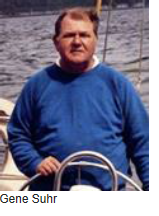

CH2M HILL’s Interest. The positive publicity the firm received for the advanced waste treatment (AWT) system in South Lake Tahoe prompted the Denver Water Board to contact CH2M HILL in early 1971 regarding the Board’s fledgling “Successive Reuse Program.” With competition along the Front Range for the available water supplies becoming increasingly fierce, the Denver Water Board instituted an extensive study to investigate the feasibility of recycling wastewater for domestic reuse. Ken Miller, the Board’s water chemist, treatment guru, and future CH2M HILL Vice President, contacted Gene Suhr to discuss the possibility of CH2M HILL becoming a member of the in this state-of-the-art opportunity, and a contract was signed.
Holly Cornell’s (the “C” in CH2M HILL) married daughter, Cindy, lived in Denver; consequently, Holly and his wife, Cleo, visited her once or twice a year. While in the area, Holly would call on City officials in the area to let them know of the firm’s interest in working for them. As a result of his efforts, he picked up a small waterline design project for the City of Aurora.
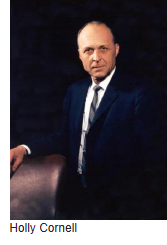
About that same time, the Corvallis office received a request for proposal (RFP) from the Metropolitan Denver Sewage Disposal District (MDSDD) to study the expansion of its large wastewater treatment plant. Due to a mailing fluke, the RFP arrived late. Sid Lasswell hurriedly put a proposal together and sent it in, not expecting that we would be selected to do the job. Surprisingly, we were.
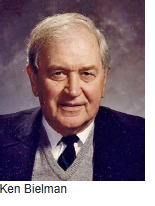
With those three projects as a nest egg, and the promise of favorable consideration for other work if we had a local presence, the firm’s partners agreed that it was time to open a Denver office. In early June 1971, Holly Cornell called Ken Bielman into his office, explained the Denver situation to him, and asked if he would be willing to move there and open a new office for the firm to serve the Rocky Mountain area. Ken agreed without considering the logistics of a permanent move and the impact on his family.
It took less than a half a day for Ken to find the Montbello complex of residential, commercial, and industrial land uses northeast of the old Stapleton Airport. The business manager was friendly, accommodating, and willing to meet our demands. Ken signed the 5-year lease that afternoon for space in the Montbello Bank Building northeast of Stapleton International Airport.
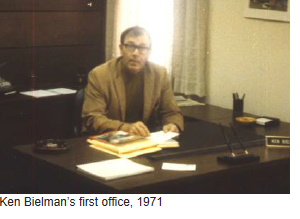
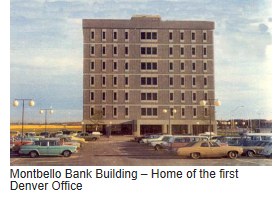
Ken got a floor plan of the space we were to occupy and sent it to architect Harry Teel in Corvallis requesting his advice on office layout, any special wall treatments for the reception area and Ken’s office, additional decorative furnishings, etc. Harry and Ken selected the basic furnishings before Ken left Corvallis and ordered them for delivery in Denver. Everything worked out as hoped; and by the third week in July, we were moved, set up, and ready for business.
The CH2M HILL managers had set up the Denver facility as an “Area Office” operating under the direction of Earl Reynolds, manager of the Boise Regional Office.

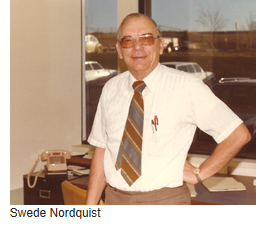
Holly Cornell visited Ken regularly and had arranged for Swede Nordquist to also relocate to Denver to manage the support functions for the office, which because of our small size only included drafting and secretarial services plus office maintenance. Ken was delighted at Holly’s choice because Swede and Ken were good friends; in spite of the fact that Ken was Norwegian and Swede was, obviously, Swedish. Besides, Ken and Swede had worked together for several years in Corvallis.
Shortly after the office move-in day, Ken started making visits to clients and prospective clients. The City of Aurora was his first stop. He met with Chuck Wemlinger, the Director of Public Works and the namesake for Aurora’s Wemlinger Water Treatment Plant in Aurora.
CH2M HILL was serving as a technical consultant for the Denver Water Department’s Successive Reuse project. Although virtually all of CH2M HILL’s involvement was being done by the Corvallis office staff, Ken called on Jim Ogilvie, Manager of the Denver Water Department, and Ken Miller, leader of the reuse program, just as a courtesy. They both seemed genuinely pleased that the firm had opened a Denver office. Ken visited with Bill Korbitz, Manager of the MDSDD No. 1, to get acquainted with another of our new clients. The sewage treatment plant expansion study was being led by Jerry Boyle in Corvallis.
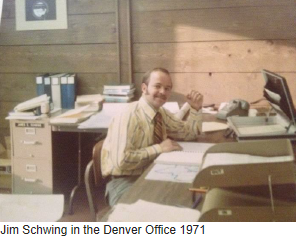
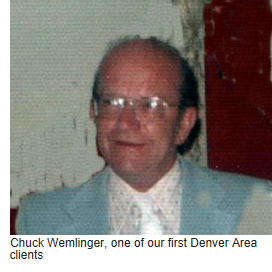
The predesign phase of the Metro Denver sewage treatment plant (STP) was progressing nicely in Corvallis, but Project Manager Jerry Boyle decided he needed another sanitary engineer in the Denver office to help with local predesign considerations. So, in the early fall of 1971, Bob Pailthorp asked Jim Schwing to move to Denver for a 3-month “temporary” assignment. Jim agreed, and he now boasts that the 3-month commitment extended to a successful 20 years in the Denver office. Jim recently retired from CH2M HILL after 45 years, where his last assignment was Area Manager of the Salt Lake City office.
Swede and Ken hired Linda Milazzo as our receptionist/secretary. Linda’s husband, Sam, was serving an overseas assignment with the U.S. Army. Linda was a delightful person – polite, sensible, competent, and with a very appealing manner; totally professional. Everybody liked Linda. One of our best clients, Chuck Wemlinger, told Ken, “I like to visit you in your office just so I can talk with Linda.”
Aurora WTP Expansion. The first project that the City of Aurora awarded the firm after the new office was opened was the expansion of its water treatment plant (WTP). The project was designed in Corvallis with Bob Beckley as the project manager.
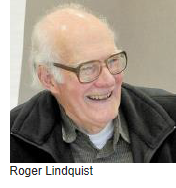
Aurora Quincy Reservoir Planning. As an adjunct to the WTP expansion, Chuck mentioned to Ken that one of their problems was that their raw water pipeline was too small to deliver enough water to the plant to meet high-water demand peaks. Ken suggested that a raw water storage reservoir near the WTP could solve that problem. Chuck remarked that if a suitable site for a reservoir could be found, he’d be willing to consider it. Soon after that, Ken spent a Saturday in the office searching contour maps looking for a flat basin in the undulating terrain within the nearby undeveloped land. He finally located a site where, at least on paper, it looked like a small dam could be constructed that would impound enough water to make the project worthwhile. Ken drove to the location and confirmed his preliminary thoughts. The dam folks from Corvallis visited the site and confirmed Ken’s assessment. With Chuck’s support, the City authorized us to proceed with the predesign study and report. Roger Lindquist was the project manager.
The new reservoir was named “Quincy Reservoir.”
Aurora Smoky Hill Reservoir. Over lunch one day with Ken, Chuck Wemlinger commented that there was a large subdivision planned along Smoky Hill Road at the southeastern limits of the developed area of Aurora. He said the tank near there may not be big enough to serve the water needs in the area. After a review of that part of the City’s service area, it was apparent that the reservoir was too low to adequately serve the area. Ken recommended to Chuck that the tank be moved further along Smoky Hill Road to a higher elevation. Dale King in the Seattle office prepared plans for the relocation of the 1-million-gallon steel tank. He spoke with a moving contractor in Seattle about the feasibility of moving the huge structure intact as opposed to cutting it apart and reassembling it at the new site.
We prepared bidding documents for the project that asked for firm prices for: (1) Dismantling the tank and rebuilding it and (2) moving the tank intact. The City received two bids. The Seattle contractor’s price for moving the tank by raising it, putting wheels under it, and towing it to the new location was substantially lower than the other option. The second bidder’s price for moving the tank intact was also lower than the dismantling option, but he bid on a different method. Rather than putting wheels under the tank, he proposed to fasten a flexible skirt all around the bottom of the tank, then pump air under the tank so that it could be moved on the air cushion rather than on wheels. His price was higher, so the wheel option was chosen.
Moving the tank was an interesting process. First, the tank was emptied; then huge hydraulic jacks were used to raise the tank off its foundation. Then very large steel I-beams were placed under the raised tank and set down on low-boy trailers with 96 wheels. Several Caterpillar-type tractors towed the big tank up the street to its new location. This method was possible because the only obstacles were power poles and fences in the way of the 64-foot-diameter, 32-foot-high tank. Those were taken down and replaced after the tank went by. The new location was over a half-mile from the old one, and it took several days to tow the tank that far. At the previously prepared new site, the tank was lowered onto its foundation in the reverse order in which it was raised. There were several pictures in the Denver Post covering this unusual project. At the new location, CH2M HILL also designed and supervised construction of a second tank at the new site, doubling the storage capacity of the Smoky Hill Reservoirs.
First Christmas Party – 1971. An office Christmas party has been a tradition since CH2M’s beginning. In reverence to that tradition, the Denver office held its first Christmas party at Laffite’s, a nice French restaurant in historic Larimer Square in downtown Denver. There were only 12 people to initiate the company tradition in Denver: Swede and Fran Nordquist; Jim Schwing and his friend, Mary; Earl and Margaret Lyda; Dennis and Linda Sandretto; Sam and Linda Milazzo; and Ken and his date, Julie. The dinners were excellent, as usual at Laffite’s; and there were many toasts to the success of CH2M HILL’s most recently established office and to the companionship of our pioneer-spirited co-workers. It was a grand kickoff for our brand new venture.
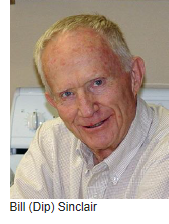
More Staff Additions. In early 1972, the office had picked up a few small projects. With the likelihood of the Quincy Reservoir moving into the construction phase, Earl Reynolds arranged for Bill Sinclair to transfer to Denver from the Boise office. Bill, or “dip” as he was commonly called, was a civil engineer with strong experience in construction inspection; a good choice to fulfill our staff capabilities. Bill’s nickname, “dip,” came from his college days. He was an instant-like guy with an infectious smile, a confirmed prankster, and would rarely pass up an opportunity to party.
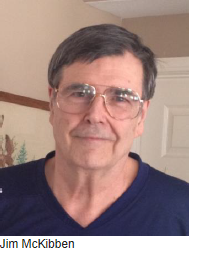
In late 1972, two more joined the firm to augment the capabilities of the Denver office. Jim McKibben from Kansas, a sanitary engineer, and Bob Jacobs, a transportation engineer also from Kansas, were hired by the Corvallis technical disciplines. The City of Colorado Springs had asked CH2M HILL for assistance in pilot testing a new process at their sewage treatment plant. Jim had been working for a couple of years following his graduation from the University of Kansas. Wanting a change, he applied for a position with six engineering firms, one of which was CH2M HILL. He went to Corvallis for an interview with Bob Pailthorp, and Bob hired him to conduct the pilot testing program in Colorado Springs. Jim and his wife, Diana, were horse enthusiasts and had several horses. After making the commitment for the Colorado Springs work, he and Diana moved to a rural area north of Denver where they had room for their horses. Jim commuted to Colorado Springs until the pilot testing was completed almost 6 months later. Then he moved into the Denver office to help with the Metro Denver STP design.
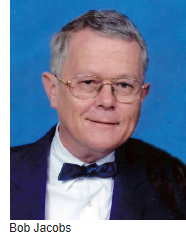
Len Schoolcraft, a traffic safety study expert from Corvallis, had obtained a rather large safety study in Kansas and had hired Bob Jacobs to help him with the project. There wasn’t an office there, so Bob worked out of his home. Unexpectedly, Bob’s house became unavailable. Without a place to work, Len asked Bob to move to the Denver office to finish the study. Thus, without the Denver office’s knowledge or input, we acquired a transportation engineer, adding another discipline to our service capability. That wasn’t a problem because Len and Bob kept bringing in new work to keep them busy. In fact, as soon as the Kansas project was finished, Len garnered a similar study for the City of Aurora. He hired Julie’s son, Scott, who was home from West Texas State for the summer, to help with traffic counts.
Metro Denver STP. In 1972, the Metro Denver STP moved into the final design stage. The design was done mostly in Corvallis with Jerry Boyle as project manager. Jim Schwing did part of the design in Denver, heading up the sludge disposal process study. Jerry made many trips to Denver to review concepts with the MDSDD staff.
1972 Christmas Party. Keeping with company tradition, our Christmas party in 1972 was a lot bigger than our first one. In addition to the Denver office employees, Burke Hayes, the second “H” in CH2M, and his wife, Billie, were the honored guests, as well as Ken Bielman’s daughter, Lyn. For the pre-dinner social hour, Billie thoughtfully supervised the making of the eggnog, as she usually did for the Corvallis Christmas party. Burke was an effective speaker. And, true to form, his address to the partygoers was warm, moving, and full of praise for the excellent work they had accomplished that year.
Lead-Deadwood Project. In 1973, we were selected to study the wastewater disposal situation for the Lead-Deadwood Sanitary District. The two towns, Lead (pronounced LEED) and Deadwood, in the Black Hills of South Dakota, were only a few miles apart. Both were sewered, but neither had wastewater treatment facilities. Our charge was to investigate the type of treatment that should be constructed and where it should be located to most efficiently serve the District. Jim McKibben was available, so he was appointed the project manager.
Lead was established in 1876 when gold was discovered. The Homestake Mine was the reason for the town’s existence and was the hometown for most of the miners and their families. Deadwood, on the other hand, was the rowdy entertainment center for the area. The Homestake was brought under control of George Hearst of the famous Hearst family in the 1890s. Hearst expanded the operation to include an 80-stamp mill and made other significant changes. It became the largest, deepest (8,240 feet), and most productive gold mine in North America. At the time of its closing in 2002, it had produced over 40 million ounces of gold and 9 million ounces of silver.
The project didn’t turn out as we’d expected. The final report was accepted by the District’s Board of Directors; but, in the meantime, the mine folks cleaned up their act and discontinued the practice of discharging the cyanide-laced tailings into the creek. With CH2M HILL’s help, the District obtained a less-stringent wastewater discharge permit; and the Board decided to postpone the construction of the treatment lagoons recommended in the report. Eventually, the lagoons were built; but CH2M HILL didn’t propose on that project.
Denver Office Workload Increases. In 1973, the Metro Denver STP project moved into the construction phase. Earl Lyda and Dennis Sandretto had finished their work in Colorado Springs, so they relocated to Denver to be the resident inspectors on the Metro work.
The design phase of Quincy Dam began in Corvallis with Roger Lindquist continuing on from the planning study as the project manager, and the Denver office designed the pipeline.
More Staff Additions. Early in 1973, we had two additions to the Denver office personnel and one subtraction. Our loyal secretary, Linda Millazzo, left us. Her husband, Sam, was transferred; so Linda had to leave us. Swede replaced Linda with an equally competent person, Nita Distel. An outgoing person with a quick-response type of humor, she could hold her own against all of the males in the office. Nita became our lead secretary when the support staff increased; and she served in that capacity for many years, eventually relocating to the Albuquerque office to lead the support staff there.
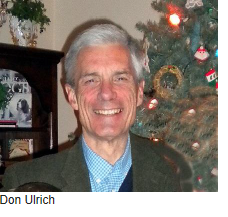
Don Ulrich. Don was the first full-time, Denver-based planner to join our staff. He had received an advanced degree in planning from the University of Oregon and was well aware of CH2M HILL. After graduation, he worked temporarily in various business enterprises such as logging, banking, brokerage, and even a few retail outlets; none of which were in his chosen field. His wife’s parents lived in Meeker, Colorado; so Don and his wife moved there hoping to find work more suited to his academic degrees. He noticed an ad in the Denver Post for a planner that we had posted, so Don went to Denver to apply for the job and was hired.
The Foothills Project. Almost all of the municipal water supply for the City of Denver comes from the western slope of the Rocky Mountains because of the semi-arid climate on the eastern side to meet the needs of the growing population on the eastern slope. Denver’s water comes from a variety of sources in the upper end of the Colorado River drainage basin. Water from these sources is collected and stored in Dillon Reservoir on the western slope. Dillon Reservoir has a capacity of 257,000 acre-feet of water (1 acre-foot equals 326,000 gallons).
From there, water is pumped into the 23-mile-long, concrete-lined, 10-foot-diameter Roberts Tunnel running under the Continental Divide. The construction of the tunnel took 16 years, from 1946 to 1962. The water is discharged into and flows down the North Fork to its confluence with the South Platte River about 40 miles up the South Platte canyon from Denver. The City pumps the water from the South Platte River for treatment and distribution.
The Denver Water Board realized that the system was subject to failure if anything happened to the conveyance system that carries the water from the western slope to the eastern slope. To minimize that risk, the most effective solution was to provide a large storage reservoir on the eastern slope. In 1967, the staff engineers came up with a plan they named “The Foothills Project.”
The essential features of the project were:
- A dam in the South Platte Canyon to create a large reservoir
- A conveyance system to carry the water from the reservoir to a treatment plant
- An additional treatment plant to supplement the older treatment facilities
CH2M HILL’s Involvement. Mostly through the efforts of Holly Cornell and his continued contacts with the Water Board’s decisionmakers, CH2M HILL was asked to lead a consortium of engineering firms to design and provide resident inspection for the implementation of this project. This project was extremely important for the Denver office as it would be one of its keystone projects and would very favorably impact the office’s profitability.
The consortium Holly put together included Harza Engineering of Chicago for the dam; Daniel, Mann, Johnson and Mendenhall (DMJM) of Los Angeles in association with Phillips, Reister and Haley of Denver for the tunnel and transmission pipeline; and CH2M HILL for the water treatment plant and management of the entire project. Fred Harem was the project manager for the predesign phase of the treatment plant.
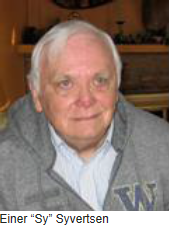
Enter Sy Syvertsen. In 1973, the Denver Water Board authorized us to conduct the environmental assessment for the Foothills project, especially the portion in the South Platte River. The impact on the herd of Rocky Mountain Bighorn Sheep that inhabited the areas of the project was one of the major elements of the study. This issue was high on the public’s list of concerns. Einar “Sy” Syvertsen, a planner from the Seattle office, was assigned as project manager for the environmental assessment (EA). He spent a lot of time in the Denver office on the EA and was treated like one of the hometown guys by the Denver staff.
More Office Changes. By 1974, the Denver office staff had grown to about 25 people; and our prospects for additional projects were excellent. Businesswise, this was a banner year for the Denver operation. The firm decided to change the Denver operation from an Area Office under Boise to a full-fledged Regional Office on its own. With that change, we were given responsibility for projects and business development in Wyoming, Nebraska, and the Dakotas, as well as Colorado.
With the number of staff steadily increasing, we occupied all of the space available to us in the Montbello Bank building by 1974. The building manager offered to transfer our lease to an adjacent building that the Montbello folks had just completed if we would move there. The new building was larger than the one we were in; and the entire fourth floor, the top floor, was available. We didn’t need the whole floor, but the lease amendment provided that the management would hold the unused space for us if we needed it within the next 5 years. We accepted the deal, and we moved into new quarters.
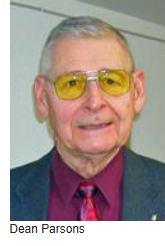
Dean Parsons. The Denver office was in need of another sanitary engineer. As luck would have it, Dean Parsons from the Corvallis office was available and willing to transfer to Denver.
More Office Changes. By 1976, the number of DEN employees had increased to 45; and the office space had expanded to occupy all of the fourth floor of the second building in the Montbello office complex. We responded to an RFP from the City of Fort Collins (home of Colorado State University) to expand their water treatment plant, and we were awarded the job. The Seattle office prepared the design. Later in 1976, Norm Ward, a water treatment specialist in the Seattle office, transferred to Denver to manage the Fort Collins project through the construction phase.
Swede and Fran Leave for Trinidad. The firm’s International Division had proposed on and won a major water system development for the City of Port of Spain, the capitol of Trinidad. Swede was asked to be the office manager for the project, which would be largely done in Trinidad by a consortium of Trinidadian engineers with CH2M HILL staff leading the team. It was a serious challenge for Swede, but a great opportunity as well.
Nita took over from Swede as Denver office manager.
BioGas Conversion Project. When Jimmy Carter became President of the United States in 1977, he implemented programs to move our country toward energy independence. Converting normally wasted resources into useful purposes, thereby saving energy, had a high priority. The huge, coal-fired power plant at Lamar, Colorado, serves a wide area in the southeastern part of the state. The many very large cattle feed lots in the vicinity produce tons of raw manure every day. In concert with the President’s interest in energy conversion, the technical staff at the Lamar Utility Board conducted some preliminary studies to determine if waste heat from the power plant could be used to convert the manure from the feed lots into methane, which could then be used to produce more electrical energy. Their initial studies indicated that the concept was worth pursuing further.
The Utility Board hired CH2M HILL to conduct further study of the concept, to prepare preliminary designs for the facilities needed, and to develop cost estimates. Rick Arber, a sanitary engineer in our Denver office, was selected to manage the project. Our findings were submitted to the Utility Board in report form with supporting drawings, cost estimates, and an implementation plan. The report was favorably received; and a private corporation, Bio Gas of Colorado, was established to carry out the project.
The American Consulting Engineers Council (ACEC) selected this project as the National Grand Conceptor Award winner. This was quite an honor for the firm and for the Denver office.
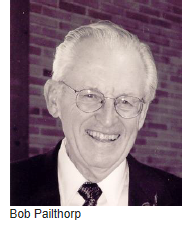
Another Move. In 1977, CH2M HILL acquired Black, Crow and Eidness (BC&E), a prominent engineering firm headquartered in Gainesville, FL, and operating mainly in the southeastern part of the country. BC&E had over 200 employees in branch offices located in Atlanta, GA; Columbia, SC; Montgomery, AL; Boca Raton, Naples, and Tampa, FL; as well as the headquarters office in Gainesville. Joe Worth, a water and wastewater engineer from the Portland office, was asked to move to Gainesville to manage the transition of the BC&E firm into the CH2M HILL organization, and then to become manager of the newly formed Southeast District of CH2M HILL. At the end of 1977, Ken was asked to move to Atlanta to take over the regional office there. Bob Pailthorp from Corvallis relocated to Denver to take over the Regional Manager responsibilities.
The 70s
The office was located just east of the old Denver Airport in the Montbello Industrial Park. Bob Pailthorp moved to Denver in 1978 to replace the first Regional Manager, Ken Bielman, who transferred to Atlanta to manage that region. Bob served as manager of the Denver region until 1984. Under Bob, the office executed water, wastewater, and some environmental assessment work conducted by Don Ulrich. We continued the construction oversight of Metro Denver’s Central Plant under the management of Jerry Boyle. We also continued water resources and water treatment planning and design projects for the City of Aurora, Denver Water Department, and the City of Fort Collins. T. Gil Haycock headed the water resources planning work that included a feasibility study on the Lake Oahe Aqueduct. The study involved building an aqueduct from South Dakota to Nebraska and to northeast Wyoming to service energy development and coal slurry pipelines to Oklahoma. A humorous note on this project, our salesperson, Don Ulrich, fouled up the interview date. He purchased airline tickets for the interview team for the wrong day. The flights were all sold out for the actual interview date, so he booked a private charter and flew the team to Pierre, S.D. Don sheepishly got into the office the following Monday morning and had a note that Bob wanted to see him and that he was upset. Of course, Don knew what the deal was. As he walked into Bob’s office, the phone rang with the client congratulating us on the win. Bob smiled at Don and said that he’d forgive the cost of the charter.
In the later part of that decade and into the 80s, we got into the energy business. We were executing water consumption scenarios for all the energy develop planned in Wyoming and Colorado, including coal-fired power plants, gasification plants, and slurry pipelines. We also did “boom town” impact studies in western Colorado and Wyoming.
The 80s
The DEN office continued to do energy work into the 1980s. One project called an “Alluvial Valley Floor Feasibility Study” (aka a coal mine business plan and EA) for Sun Coal Company. This was the most highly cited coal company in the U.S. for environmental violations. The work involved forecasting coal production, revenues, costs, renovation plans, and environmental impacts. We had 12 people in the Mining Department through the 80s.
The transportation group started up in the early 80s doing work mostly for the Colorado Department of Transportation (CDOT). We hired Tom Ragland, Chris Bisio, Bill Carley, and several other strong folks who built the program. Tom also did some park and ride work for the Denver Regional Transportation District (RTD). In the 1980s, the Denver Office accomplished several Area-wide Water Quality Management Plans required by the Clean Water Act, also known as EPA Section 208 Studies. One such plan was for the Denver Regional Council of Governments (DRCOG). The DEN office did subsequent projects all over the U.S. including Illinois, Alaska, Wyoming, St. Louis, and Omaha. These were big studies with fees a $1 million or more, which was a big contract in those days.
We continued doing work for the Metropolitan Denver Sewage Disposal District (then referred to as Metro Denver) including wastewater facility plans for their three drainage basins: Clear Creek, Sand Creek, and Lower South Platte. We also designed a major sewer interceptor and pump station and force main, and a sodium hypochlorite feed facility to serve the northern reaches of Metro Denver’s system.
The 90s
Transportation – The Transportation Group completed major work for Denver Regional Transportation District (RTD). These projects included an alternatives analysis and draft and final Environmental Impact Study (EIS) for the SW Corridor Light Rail line. This was a first for CH2M HILL and started a long relationship with RTD. The DEN office executed significant projects for RTD on LRT and Commuter Rail projects, up through the 2000s. We also did the infamous Mountain corridor project, which looked at the feasibility of building a high-speed (Maglev) train from Denver International Airport (DIA) to the ski areas. The projects endured challenging politics but were very interesting.
Hazardous Waste – In the late 80s and into the 90s, we added the Superfund work to the ledger. The DEN office managed the EPA Region 8 Remediation and Field Investigation Team (REM/FIT) program. REM/FIT was the first nationwide EPA Superfund program. The overall effort was administered from the WDC office. Bob Davis was the first Denver Program Manager for CH2M HILL’s effort for this Superfund program. Following REM/FIT, CH2M HILL won the nationwide EPA Alternative Regional Contracting System (ARCS) Program Management contract; and the DEN office executed this program for EPA Regions 6, 7, and 8. In 1988, Jim Schwing replaced Bob Davis as the Program Manager when Bob transferred to the Dallas Office. Under these EPA Region 6, 7, and 8 programs, we managed environmental assessment and cleanup for such sites as the Lowry Landfill near Denver; California Gulch mining site near Leadville, CO; and Anaconda Smelter and Anaconda mining sites in Montana. In 1991, Don Ulrich took over the program management when Jim transferred to Pittsburgh to manage a major hazardous waste project for Westinghouse. The Hazardous Waste group was the largest practice in the DEN office during this period.
Telecom – In the late 90s, we got into the Telecom business. Our first project was for US West. We were told that we were hired because of our project management skills, which compared to the industry at large were superior. We were told by the client we were hired because “I don’t get any arguments over technology; but I could tell you guys to put a rope in the ground, and you’ll do it faster than any of the big boys I deal with.” Since telecom was really a “first to market deal” and compared to doing a rail line or a major sewer or a roadway, quick project delivery was of utmost importance to the client. US West awarded CH2M HILL approximately $100 M in program management work over the next 10 years. Following the work for US West, CH2M HILL executed work for telecom companies in Malaysia, the UK, France, and Germany.
2000’s
The office really got rolling in the early portions of this decade, with all the business groups going strong. The office added construction to its Transportation group, which had mixed success. Further, we added market segments in Energy and Power, including construction.
After Bob Pailthorp retired, Doyle Tinkey took over and remained in the position for several years. Following Doyle, Peter Binney was appointed Reginal Manager and held the position for a couple of years before leaving to take an Executive Job with the City of Aurora. Following Doyle, Don Ulrich became RM followed by Amy Lange.
The office moved to Greenwood Village near the Denver Tech Center in the late 1970s. The staff was about 30 and was made up of predominantly in the water resources, water treatment, and wastewater treatment disciplines in 1978.
Major clients were the Denver Water Board, City of Aurora, and Denver Metro Water Reclamation Plant. DEN clients expanded in CO and developed in OK, TX, NM, and NE.
Denver spawned several Area Offices. ALB was managed by Scott Ahlstrom followed by Dave Wilson. Prior to this, we had opened a one-person office in ALB and staffed it with a mining engineer from STL. Kent Robinson and Murry Fleming were instrumental in developing work in ALB and Tulsa, respectively.
Denver became the Central District and firm headquarters in the late 1980s. The client base expanded to civil, water resources, and industrial services.
Work for Sandia Labs in ALB was originally developed in Boise. Scott Ahlstrom was project manager on efforts to irradiate sewage sludge using nuclear biproducts. Projects for Sandia led to expanded nuclear capabilities in DEN.
Several novel projects were a concept study of a water system for an oyster-growing plant to be located in Lamar, CO; and concept studies for a large cattle manure biogas plant, also in Lamar; and design and start-up of the Ce 137 medical products irradiator for Iotech in Northglenn, CO.
The Birth of the Great Lakes Region and the Milwaukee Program Management Office
By Mike Anglea, January 2008
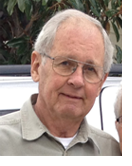
In the early 1970s, the Milwaukee Metropolitan Sewerage District (MMSD) was under pressure from the State of Wisconsin and the City of Chicago to upgrade the treatment of the wastewater of the metropolitan region.
Historically, the MMSD had generated operating revenues by way of an ad valorem tax on all properties within the District. Also, capital expenditures for upgrades and expansions to the region systems had been carefully managed to not create undue anxiety within the community. To compound the problem, the District’s capital funding came from Milwaukee County. The District did not have its own capital funding authority. The result of this arrangement was a serious shortfall in needed improvements over many decades.
With the advent of the USEPA and its construction grants program, the MMSD desired to receive the maximum grant funds possible. However, before this could happen, the method of generating operating revenues had to be changed to reflect a more accurate impact by individual users of the system. It was clear that the breweries, tanneries, and many other industrial dischargers were not paying their fair share of the operating costs based on the ad valorem tax system. By 1974, the MMSD was ready to change the system and undertook an effort to select outside assistance.
As a result of Tom Gibbs’ relationship with Bob Borchardt, Chief Engineer and General Manager of MMSD, developed through their work with the Association of Metropolitan Sewerage Agencies (AMSA), CH2M HILL became aware of this opportunity.
Earlier, the firm had obtained a sludge management project for the City of Madison, Wisconsin, through the efforts of Jim Poirot, Lyle Hassebroek, and Don Marske. This project was being managed by Don from Corvallis. A decision was made to pursue the User Charge/Industrial Cost Recovery (UC/ICR) project. I was approached in late December 1974 about moving to Wisconsin and managing this project if we were successful in its pursuit. A couple days later, after discussing the opportunity with my family, I agreed to take it on. Soon thereafter, Tom Gibbs and I were in Milwaukee to learn as much as possible in preparation for the competition to follow.
On our first visit to Milwaukee, we learned that the District staff had developed a capital program of more than $400M. This was eye popping. We knew that if we could get into Milwaukee with the UC/ICR project we would be in a good position to get some portion of the $400M. This definitely was an added incentive to pull out all the stops in our efforts.
We were short-listed and interviewed on a Saturday morning in June or July 1974. After the interview, Tom and I flew back to Seattle and Boise. The next day, we got a call from Bob Borchardt saying that we had been successful in our efforts. By November, we were on our way to Milwaukee to open the project office. We had convinced Don Marske to relocate to Milwaukee also, along with Walt Kashevarof as our technician. In June 1975, the firm’s board designated Milwaukee as the Great Lakes Region.
We were proceeding well with the UC/ICR project and were developing good relationships with Bob Borchardt, his staff, and the District’s board.
The winter of 1974/1975 was long and very cold. In early spring, the area received a severe storm event. The storm was in the form of snow in the northern portion of the District’s service area. However, in the southern portion, it rained. With the ground still frozen, all rainwater entered the combined sewer system, which was prevalent in the area and made its way to the District’s South Shore Treatment Plant. The influent bar screens plugged quickly and overflowed into the tunnel system of the plant. Floodwater flowed throughout the facilities, shutting down the plant for a number of weeks.
This event spurred MMSD into action. Bob Borchardt identified a half dozen areas for investigation and developed a request to spend $25,000 on each. In discussions with Bob, I suggested that this was a drop in the bucket; and it would take much more to properly address their issues. He agreed, but this was all he felt he could go to his board with at the time. Over the next few weeks, Tom Gibbs, Lyle Hassebroek, and I discussed Milwaukee’s issues and concluded that they needed a major program similar to the one that Tom led in Seattle in the 1960s.
The same day we came to this conclusion, I attended an MMSD board meeting at which Bob Borchardt wanted to get approval of his minimal program of study of each of their key issues. During the discussion, one of the board members commented that he didn’t think this would get the job done and felt their issues were bigger than MMSD could handle on their own and they needed major help from outside. I about fell off my chair. At a break in the meeting, I went up to Bob and told him we needed to talk. I told him of the conversations that Tom, Lyle, and I had been having. The next morning Bob called me asking to meet at our office. We discussed their many issues and how they could be addressed. We drew up an organization chart showing how a broad-ranged project could fit into the MMSD organization. Bob liked this.
Over the next few weeks, Bob developed and warmed more to this idea and decided to implement it. He wanted us involved in a major way; but because of EPA procurement guidelines, he was compelled to put the work out for national competition. We assisted in the preparation of an ad for Engineering News Record (ENR). At a meeting in Portland with senior people within the firm, it was suggested that maybe we were biting off too much by going after the entire program and maybe we should be satisfied with letting some other firm lead the team. Tom Gibbs and I felt strongly that we were in a very good position to win this in the lead position. This was ultimately agreed to. Tom agreed to relocate to Milwaukee to manage the initial years of the program. We proceeded to assemble a team of mostly Wisconsin firms with Bob Borchardt’s support. After a lengthy competition, our team was successful. Then began the preparation of a contract covering program management, design, and construction of a multi-year, multi-faceted pollution abatement program.
During the contract development phase, a meeting was held with EPA in Chicago, which included Bob Borchardt, Bill Katz, Tom Gibbs, Harry Teel, and me. Tom, Harry, and I were left cooling our heels in a room while Bob and Bill met with some of the EPA folks. They returned after a lengthy period of time and informed us that EPA would not go along with the program. They could not bring themselves to accept the idea of a single firm “locking up” such a long-term program. The EPA folks had just come from an AGC meeting in California where we suspected they got a lot of heat from some of the larger contractors over allowing a consulting engineering firm to get in the program management business. MMSD was ready to go back and start the process all over again. We said we were not willing to cave in so easily after spending months and a great deal of money on the effort. Tom asked that we be given a week to get EPA to change its mind.

The next day, Tom and I went to Washington, D.C. for a meeting with Hal Cahill, EPA’s director of construction grants. Tom and I made a presentation of the program and our approach to meeting Milwaukee’s needs. At the conclusion, Hal commented that he didn’t see how the program could be satisfactorily accomplished any other way. A few days later, MMSD got the go-ahead from EPA.
The PMO became a reality in July 1977. Within a couple days, we were heavily involved in directing MMSD’s response to the Federal Court action against the District. The rest is history.
Since Mike wrote the foregoing history, David Gee, with the help of several of the program’s alumni, has prepared a comprehensive history of the Milwaukee Water Pollution Abatement Program. See the attached PowerPoint presentation (PDF) MWPAP 1977-1995. (Speaker Notes for the slides can be accessed by the toggle ‘cloud’ located in the upper left corner of each slide.)
Pacific Islands Office As recalled by Don Marske
The history of the Pacific Islands Office (PIO) starts with recollections from Gene Suhr and Les Wierson describing their first ventures to Hawaii in the late 1960s. It was Les, who leveraged a cold call from Norman Saito of Norman Saito Engineers of Maui, who, with Norman, won the Kihei Project, the first significant contract in Hawaii and the stepping stone to become the firm’s “Bridge to the Pacific Rim.”
The 1970s saw Les, Joe Worth, Tony Groh, and Gordon Koblitz, in partnership with Norman Saito, implement the Kihei project. It was this work that Dann Madden used to leverage our presence in the Pacific Islands. The 1980s started with Dann opening an office on Maui that was manned by Don Marske, Mike Conway, Glenda Hayashi and many visitors from the mainland offices. The Maui office also hosted OMI’s Contract No. 1 managed by Bernie Miller, employee No. 3 of the new subsidiary. The Honolulu office was opened in mid 1980 where Jenni Wong, Bob Chuck, Maurice Kaya, and again more visitors from the West Coast and beyond joined the firm. The 1990s were years of restructuring led by Mike Kennedy, Bob Chuck, Paul Luersen, and Ross Kaneko.
Today, the 2000s represent the truly breakout years for the office. Led by Paul Luersen, Ross Kaneko, Dennis Peters, Pete Magallones, and more recently, Chris Williams, the office is now some 70 strong with annual billings of $24 million doing a wide variety of work throughout the Pacific Islands and Rim. The Honolulu office is now clearly the firm’s Bridge to the Pacific Rim.
In the beginning …
Gene Suhr recalling the firm’s first foray into Hawaii, circa late 1960s.
A good friend of CH2M, Bob Belt, who had been a planner working in Portland was one of the principals in the engineering firm of Belt, Collins & Associates (BCA) in Honolulu. Mostly through his efforts, CH2M joined with BCA to propose on a major wastewater project for the Sand Island STP. I went to Honolulu to write the proposal at BCA’s office. I recall that the first day I reported to their offices, I was dressed in a suit and tie. Bob Belt took me aside and handed me an aloha shirt and told me they didn’t “dress” on Fridays. Together we made what I thought was an impressive proposal. I particularly remember that we bound a flyleaf into the document that was a sheet of translucent vellum with a map of the islands and a quote from Mark Twain, ‘The loveliest fleet of Islands ever anchored in any ocean.’ Sid Lasswell came over for a few days to help put the finishing touches on the proposal.
One other fond memory about this effort reminds me of what a true gentleman Bob Belt was. When it was time to leave, he took my ticket to expedite things and noticed it was a coach class fare. He immediately said that that just wouldn’t do and bought me a new first class ticket. It was my first time in first class and I must admit Continental Airlines really made things nice up front.
Les Wierson recalls the firm’s first contract in Hawaii.
By the early ’70s the Portland office (PDX) had grown to the planned 100 employees. We were struggling to find new significant long-term clients. Boundaries limited our growth north, south and east. The office had no discipline core except planning. We did not have a western boundary.
In 1971 Normal Saito of Norman Saito and Associates called on Wierson to ask CH2M to partner with his firm on Maui. Saito’s firm was a small but well respected company. They did civil projects for the County of Maui and private clients. Norman’s wife was the Director of Public Works’ secretary for many years. After consulting with Sid Lasswell we agreed and sent qualifications to Norman. Sometime later (2-3 weeks) he called to tell us we had won one of the three projects (Lahaina) and to come as soon as possible. When I arrived we learned the project was Kihei, not Lahaina. Kihei at that time was a dusty strip of houses on a beautiful Pacific shoreline. I was somewhat disappointed, but later found this was the best of the projects. Saito did the sewers. CH2M did the pump stations, treatment plant, advanced waste treatment (AWT) for park irrigation and deep well injection for disposal – all cutting edge technology. Gordon Koblitz and Dick Humphrey took lead roles in delivering an award winning project. Joe Worth helped expand our work in Maui to include water supply to Kihei/Wailea and expansion of sewerage to the Japanese development in Wailea.
Being halfway across the Pacific we were tempted to look for other opportunities. The CH2M Board gave the okay for PDX to develop work in the Pacific Rim and the Seattle office (SEA) to explore western Canada and Alaska. (Clair Hill had an office in Anchorage). With Toray Engineering of Japan, we conducted pilot projects in AWT, ammonia stripping, etc. It never led to big projects, but it was a good learning exercise in working in foreign countries. The PDX office also worked in American Samoa and Guam. The Hawaii operations initiated early with the U.S. Pacific Fleet operations and other military branches.”
The 1970s
The Kihei Sewerage System started in 1971 with a study recommending a 3 million gallon per day (mgd) plant. During review, the size was increased to 4 mgd to accommodate serving the adjacent Wailea development. Gordon Koblitz/PDX and Joe Worth/CVO took lead roles in delivering the wastewater and water supply systems for the project.
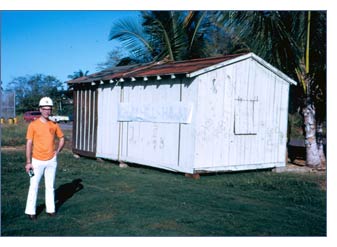
Design commenced in 1973 on a system that would stretch 7 miles from North Kihei to the entrance of Wailea. The system included 23 miles of pipe, seven pump stations, a complete-mix activated sludge treatment plant, effluent storage, partial tertiary filtration for 0.25 mgd for Kalama Park irrigation and an irrigation system for beneficial reuse of the remaining effluent to meet the no ocean discharge permit requirement.
Construction started in 1974 at a total cost of $10 million using only county and state funds. It was the largest public works project for Maui County to date. Construction challenges included the blasting and removal of 30,000 cubic yards (cy) of rock, placing 2,700 cy of concrete and dewatering issues with the caisson construction of the seven pump stations next to the ocean. The Kihei Project won the1976 Water and Wastes Engineering’s First Place Award for Engineering Excellence, as well as the First Place Award for the Hawaii Consulting Engineers Council.
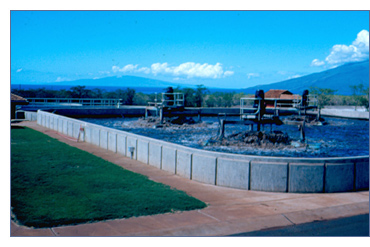
Other Hawaii work included support for Chung Dho Ahn in late 1974 for a facilities planning project for Kaneohe, Oahu; Waiehu Pump Station additional work with Warren Unemori in early 1975; Industrial Cost Recovery (ICR) study for Maui County in mid-1979; and an emergency pumping system and preliminary engineering study for Amfac’s Kaanapali, Maui STP in late 1979;
With our foot in the door, I handed the Pacific Island reins to Dann Madden/PDX. Dann leveraged our Maui presence to American Samoa, Guam, the Trust Territories, and other Hawaii work. Dann was very fond of the people in the islands and the island people were very fond of Dann.
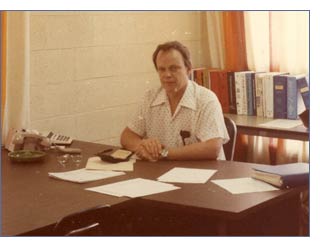
The work in American Samoa was built largely on Dann’s relationship with Dan Stock, a U.S. Public Health Service officer who was on duty in American Samoa and the Trust Territories. We worked with Dan on several water and wastewater projects over the next several years. Dan eventually retired from the USPHS in 1983 and joined OMI as their Director of Technology. He later became the Director of Quality Assurance before retiring in 1985.
The work in Guam started with Juan C. Tenorio, a consultant on Guam and the Trust Territories. Later, Dann worked with John Duenas and Dan Swavely of Duenas & Swavely, a strong civil and planning consultant on Guam. This relationship led to several interesting water, wastewater, and power projects on Guam, Saipan, Truk, and Pohnpei.
The 1980s
Dann Madden, then the PDX Regional Manager and project manager for a major tunneled sewer interceptor for the Milwaukee Water Pollution Abatement Project, offered Don Marske a transfer from the Milwaukee office to Maui to manage an Operations Management Study of the Maui DPW Wastewater Management System. The study was to provide the entree for a physical presence in the islands.
The first office was pretty spartan – a bungalow behind the old Kahului Railroad Station – but a step up from the Kihei shack. Under the general tutelage of Dann Madden and our den mother Glenda Hayashi, the office started to grow and by the end of 1980 had several new faces including John Turner, Bob Pietersen, Ed Schmidt, John Wilson, all with OMI.
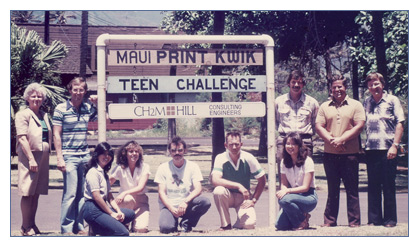
The Operations/Management Study was completed in early 1981. Other early 1980 work included Amfac’s 3.5-mgd Kaanapali STP in 1982 in joint effort with the Maui County 3.2-mgd Lahaina STP in association with Brock & Associates in early 1982; and the Molokai 0.3-mgd RBC STP for Kaunakakai in mid-1982. This new work resulted in several new task orders for the office – and a whole new set of visitors.
The staff included two outstanding summer interns from the local high schools – Diane Taniguchi (left) and Lynn Kawamura. Diane joined the firm after graduating from Cornell and then went to the City of Salem and is now the Director of Public Works for the City of Albany, Oregon. Lynn went on to graduate from Stanford where we lost track of her.
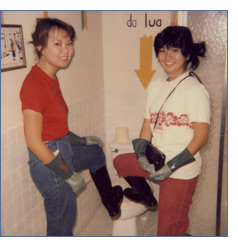
The first summer picnic gathering included the Operation & Maintenance, Inc. (OMI) crew including Bernie Miller/Maui project manager and Employee No. 3 of OMI; Bob Pietersen; and Ed Schmidt all with OMI. The Maui project was Contract No. 1 for OMI. The Maui contract was a real challenge for OMI. Bernie tells the story of an operator at the Kahului plant who he was continually trying to get to do more work. Eventually, in frustration, the operator came to Bernie’s office and told him, “Bernie, I work for the County. I’m 44 years old and haven’t worked a hard day in my life, and I’m not about to start.” But Bernie prevailed. Eassie Miller, a Maui local and OMI alumna, is now the Maui Director of Water Supply and Jeff Eng, another OMI alumna, is the current Wastewater Division Manager.
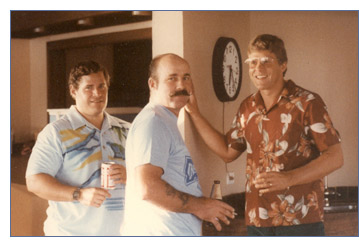
The 1981 Christmas Party featured Bernie Miller as the “local” da kine Santa. We had several guests that year including Nancy Tuor/PDX, Randy Naef/CVO; Ralph Hayashi and Dann Madden/PDX; and Gary/CVO and Marla Fries.
In the summer of 1982, Diane contracted typhus when Mike Conway sent her down a pump station where she got bit by a flea. The most debilitating effect, according to Diane, was she couldn’t touch alcohol for a year! 1982 also featured the South Pacific Conference in Pago Pago, American Samoa. This was a big deal – akin to a United Nations of the South Pacific. It offered an opportunity to learn about the issues of the island nations and cement existing client relationships and build new ones.

The 1982 Christmas Party included special guests Gene and Babs Suhr from CVO, Bill Johnson/PDX, and another visit from that special “local” good sport Santa, Bernie Miller.

In 1984 the office hosted an Alternative Water Sources in the Pacific seminar, a major marketing effort to introduce the firm and its capabilities to the clients of Hawaii and the South Pacific. Preparation for the seminar was truly a family affair with both Don and his wife Joan and Mike Conway and his wife Jo engaged in the presentation and hosting.
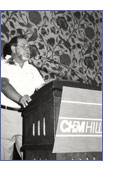
The seminar was keynoted by Gene Suhr with several other distinguished guest and expert presentations by Bill Byers/CVO, Peter Binney/DEN, Bob Charley/RDD, Maui Mayor Hannibal Tavares; Bob Chuck, Director State Water Resources; Kees Corsmitt/PDX, and Jim Mavis/SEA. The program was well attended by a wide range of clients including Bill Haines, Maui Director of Water Supply; Kazu Hayashida, then Director Honolulu Board of Water Supply; Ralph Masuda/Maui County; Art Henderson, President Maui Electric; and Manabu Tagomori Deputy Director of State Water Resources Board.
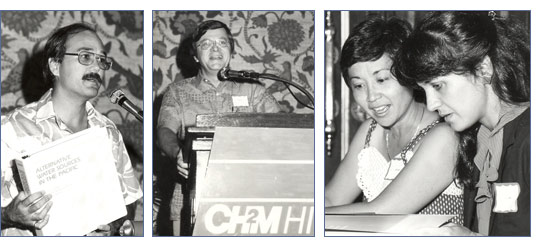
It wasn’t long before we got a return for the effort. A sampling included a very interesting desalination research facility study for the State Department of Land and Natural Resources, and a small desalination project for the Corps of Engineers (COE) for Kwajalein (Stu Davis/PDX). This was a two-stage vacuum flash evaporation system using waste heat from the diesel electric generators on the island – may have been the first desalting project for the firm using that technology. The office was also awarded a computer modeling of the Honolulu water system led by Russ Stepp, now the President and CEO of R.W. Beck in Seattle, and Ernest Lau for the Honolulu Board of Water Supply. Another interesting assignment was the commodities (papaya) irradiation project led by Jack Savinski and Scott Ahlstrom/ABQ. Unfortunately, the anti-irradiation people picketed the grocery stores on the West Coast bringing a quick end to the project.
The signature project of this period was the design-build Schofield Barracks air stripping water treatment. The office received a very nice commendation from the COE for a job well done. Kudos goes out to Tom McBriar/SEA, PM; Bob Schilling/SEA, mechanical design; and Bill Byers/CVO, process engineer.

Gordon Koblitz/PDX kicked off 1985 with the construction of the Kaunakai, Molokai wastewater treatment facility with Bill Mori, Molokai’s Plant Operator. Today the facility is home to several endangered wetland birds making it an “awesome birding” site for water birds, endangered coots, endangered stilts, the Pacific Golden Plover, Wandering Tattler, Bristle-thighed Curlew and more.
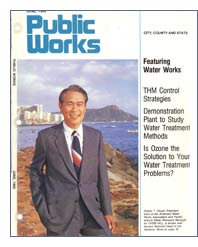
1985 also brought Bob Chuck into the Honolulu office and in 1986 he was elected President of the American Water Works Association and was featured on the cover of Public Works magazine. Bob’s introduction to the firm had some interesting history. It seems that Bob was a classmate of Dolores Beazel who was, at the time, the .70s Discipline Assistant. On one of his many trips to the Islands and before Bob’s hiring, Dolores asked Gene to take Bob and his wife to dinner. In Honolulu, Babs Suhr dutifully attempted to telephone Bob. At the time, Bob was being besieged with phone calls from salesmen. Somehow he decided that Babs was an encyclopedia salesperson and somewhat forcibly ended the nascent invitation call. Only later, at a water resources seminar where he and Gene were program speakers did he find out, to his chagrin, that Babs wasn’t a salesman for Brittanica! But the story doesn’t end here. Shortly after being hired, Bob visited the CVO office so that he could be introduced to the various disciplines that would be supporting work in the Pacific Islands. Now Gene had been harboring a desire for “revenge” over the phone-call incident and saw this visit as a golden opportunity! After effusively welcoming Bob, Gene expressed a certain “bewilderment” about the Hawaiian language and its prolific use of vowels which made for somewhat difficult pronunciation. As an example, Gene wrote on his blackboard: Pi Pe Li Ne and asked Bob how that would be pronounced in the Hawaiian language. Bob took the bait, hook, line and sinker and replied “Why pip-a-li-ni of course. Gene replied with a smile, “That’s funny, on the mainland we say pipeline.”
In early 1988, responding to low profitability pressures from Corporate, Mike Kennedy issued an internal memo announcing a consolidation of PIO operations into the PDX Region. This included the transfer of Don to Los Angeles, the appointment of Maurice Kaya as office manager, and a reduction of other staff to match workload. This announcement was followed by a decision to close the office which resulted in the resignation of Maurice Kaya, Jenni Wong moving to Gray, Bills and Hong, and the majority of the remaining staff moving to other opportunities.
Despite this turn of events, Bob Chuck, Dick Ivey, and Mike Kennedy continued to fight for the “project office.” The fight was aided by the fact that the office still had several planning contracts with several major clients including Hawaiian Electric, Hawaii Electric and Light Company, Corps of Engineers, State of Hawaii, and Herbert Horita and Jack Myers, local developers. To fulfill the contract obligations to these valued clients, Dick Ivey was instrumental in hiring Al Lyman, transferring Paul Luersen from SEA, and engaging several TDYs from other offices to complete the work. This work allowed the office to stay viable. The announcement to close the office was never published, and Bob Chuck was named to replace Maurice as the PIO Manager. Whew! Close call.
The 1990s
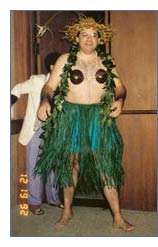
From 1988 to the early ’90s, the PIO office continued to serve the Honolulu clients below the corporate horizon. To get their heads above water, Mike Kennedy made a deal with Paul Luersen and the HNL team: “If you make Plan (’92), I will dance the hula.” They made Plan! In retrospect, Mike’s challenge was the single most critical event that forever changed the fortunes of the PIO. And the rest is history.
The office continued to thrive through the mid ’90s serving primarily Hawaiian Electric, Bishop and Campbell Estates, and Honolulu Board of Water Supply. By 1997 the work grew to the point where the 1585 Kapiolani office had to expand to the 14th floor. The Open House was a gala affair with many friends and clients joining in the celebration.
2000 to Today
The office has grown dramatically over the past decade. In 1998, the total revenue was just over $6 million with a staff of 15. Over the next couple of years the growth was slow but steady while quietly expanding markets and skill sets to include environmental work with the Air Force Center for Engineering and the Environment (AFCEE). During this period, the office also renewed its water and wastewater work and rebuilt its staff.
The office really took off in 2002 when AFCEE started a new program that resulted in several design-build renovation and repair projects on Air Force installations in Asia. Staff grew from 20 to about 40 and gross billings ballooned to $18 million. This flywheel allowed the office to enter and expand in other markets including GIS, design-build in water and wastewater, and transportation.
Today the little ole office has grown to over 70 full-time people doing work all over Hawaii and throughout Asia-Pacific including Johnston Atoll and Korea. Looks like the office has achieved the strategic goal of the early managers: Become the Gateway to the Pacific Rim. Thanks go out to Les Wierson, Dann Madden, Dick Ivey, Bob Chuck, Mike Kennedy, and Paul Luersen for keeping the dream alive.
In June, 2008, Don returned to Honolulu to visit with Paul Luersen and Bob Chuck to find that they recently moved downtown to 1132 Bishop Street. Yes, Bob still comes to the office almost every day. He enjoys mentoring the young people in the ways of client relationships, and yes, he still shoots his age (84) in golf.
Postscript
I had the privilege and honor to manage the operations of the Pacific Islands Office from 1980 to 1988. From the beginning, I knew it was going to be a special time for my family, several members of the firm, and myself.
The assignment allowed Joan to return to her home and family and it allowed our children to get to know their grandparents, uncles, aunts, and cousins. It was a short 8 years, but the impact of that time continues to influence their lives today. The PIO has also allowed several members of the firm to experience the magic of Hawaii. For some it may have been a short project assignment, for others it meant an extended visit for them and their family. For all of them, I’m sure the experience also remains a very special memory. For me, the assignment was a growing experience. In retrospect, there are some things I wish I could do over again; but overall, I truly enjoyed the assignment, especially sharing the work with our many visitors to the islands.
The foregoing is an excerpt from a larger photo journal that was drawn from a scrapbook that I kept. However, the story of the office would not be complete if it were not for the contributions of Gene Suhr, Les Wierson, Gordon Koblitz, Mike Conway, Bernie Miller, Bob Chuck, Paul Luersen, and Stu Davis. To all, Thank You.
If anybody is interested in seeing the unabridged version of the history, please feel free to drop me a note at donmarske@gmail.com.
– Don Marske, January, 2009
Portland, Oregon
As recalled by Les Wierson
The Portland office (PDX) was started by Lloyd Anderson in the early 1960s. Jim Howland was the partner in charge and managed the start-up goals and operation of the new office. John Denny was our long term P.R. Expert and political advisor in Portland. John brought Lloyd to Howland’s attention and assisted in the hiring. He advised Anderson not to go to CVO but hold out for the PDX location. Lloyd managed the office until around 1969 when he was appointed to a vacant City Council position, serving 5 years, then was Director of the Port of Portland for 13 years, and is still a civic leader in Portland. In my view the Portland Downtown Plan was the most significant planning project we did in the ’70s and Dick Ivey is still remembered for his work on that plan, a true milestone in our development.
The Portland office as conceived by Howland and Anderson was unique. The office had no regional responsibilities, only to do planning projects or assist in planning efforts throughout the firm. I believe this was a factor in the origin of the discipline system. In 1967 Ralph Roderick won and negotiated a contract with the City of Portland (Commissioner Bowes) for the Northwest Industrial sewer interceptor. Ralph, Gene Suhr and Les Wierson met with Commissioner Bowes and we started the project. Gene and Les worked out of the PDX office for a week or two. Our arch rival at the time, Stevens and Thompson (S&T), dusted off an old contract they had for the work. Commissioner Bowes asked Ralph to stop work and not bill the City. Ralph agreed with a promise of future work. It never happened.
Both Ralph Roderick and Jim Howland were convinced that we could win more engineering work if we had a Portland engineering presence. (Jim Howland was the lead on the Portland Dock Commission work-Terminal 2, etc.) The partners agreed (Cornell, Howland, Hayes, Merryfield, Rice, Reynolds, Roderick and the new ALPHW group, Adams, Lasswell, Phillips, Harem, Watters). Howland asked for volunteers to move to PDX and to start an engineering section. Everyone wanted to stay in CVO. Wierson was asked (I think Lasswell and Roderick had a hand in this) and I said yes. We moved to Portland, I think it was in August 1967. The office was located in downtown Portland with 12 people all supporting the planning efforts.
From the start, boundaries had to be established. We only were chartered to do wastewater projects from Portland and of course planning. CVO had long-term relations with Parkrose Water District, City of Camas, City of Lake Oswego, Frontier Leather Co., Portland Dock Commission, etc., and retained exclusive rights to those clients.
Earl Reynolds in Boise had pioneered how regional officers can work together; work exchange, multiplier, etc. In PDX the big question was geographic boundaries. It was decided that PDX would have counties in Washington up to and including Skamania County, on the Washington side of the Columbia River. On the Oregon side, Clatsop, Columbia and Multnomah counties including Washington and Clackamas county. Woodburn on the south was a do-not-cross area.
Not a large area but no western limit was established. That proved to be a later factor in Hawaii and International efforts. A business plan was developed in CVO. Ralph Roderick would continue to pursue the City of Portland (it took another 6-7 years before we won a job). Wierson would cold call (Roderick style) the smaller cities around Portland and Clatsop County. Many of the sewerage projects were started by Farmer’s Home Administration “small city” study grants. In the first year or two we were working for the cities of Troutdale, Tualatin, West Linn, Cannon Beach expansion, etc., plus county service districts in Clatsop and Clark counties. In the late ’60s we were able to win two major clients, Clackamas County Service District No. 1 and Washington County Unified Sewerage Agency Rock Creek Service Area.
Clackamas County came to us because of a newly elected commissioner, Tom Telford, who had worked for Stevens and Thompson (S&T) and held strong negative feelings about them. Telford introduced me to the new Public Works Director, John MacIntyre. We developed a strong mutual respect and friendship that lasted until his untimely death of a heart attack at 40, in the early ’80s. The PDX office expanded to over 50 because of these projects.
Unified Sewerage Agency (USA) became a client in a little different manner. We lived in Washington County and I volunteered to help on the speakers’ panel to form the County Service District and to pass the bond issue. We had no conflict because CH2M was not engaged at that time. I became good friends with the county administrator and arranged a visit to our plant in Lake Tahoe for the commissioners. When USA was formed and the bond issue approved Washington County asked both CH2M and S&T to submit proposals for the design. This was a significant break through since S&T had done all the preliminary work. The County selected S&T to do half the work, Fanno Creek drainage basin and CH2M to do the Rock Creek basin including the advanced waste treatment facilities needed in that basin. These two projects provided a steady stream of work to the PDX office for over 20 years and probably continues today. The AWT Rock Creek plant was another star in CH2M’s crown. All plant, pump station and special work was done in CVO including all smaller projects in suburban communities.
In the late ’60s Joe Worth moved to PDX to develop water projects and become assistant office manager. Worth and Wierson were in many ways opposites but together formed a strong management team. Joe Worth truly led the “Young Turks” of PDX. By the mid ’70s we tried to cap our growth at 100. We were somewhat successful, but the dynamics of the time were a real challenge. Bill Johnson moved to PDX to establish civil work and Ken Durant came on board to start our Industrial, Electrical, Mechanical Division. Joe Worth and Arlen Borgen were the catalysts of this hire. I was an interested bystander. Ken brought Wayne Hanson for Air Quality work and promoted construction management. From this group came IDC. Worth and Wierson supported the new Company. Durant, Archie Rice and LaMont Mathews made it happen. Ken Durant and Wayne Hanson made it work–another story, another Chapter.
By the mid ’70s CH2M was a dominant player in the Portland geographic area. We had nurtured a team built on growth but our client area was very small. This led to expansion in Hawaii and International (we had no western boundary) and IDC.
Salt Lake City Office Early Years – 1979 through the 1980s
By Jim Schwing and Sheldon Barker, December 2017
The Salt Lake City (SLC) office opened in 1979 to provide water engineering services in Utah. Under the CH2M HILL management model at that time, the office was an area office to the BOI Region and under David Bennion, the BOI Regional Manager at the time. The first office was located in an office park near the Salt Lake International Airport. The first SLC Office Manager was Larry Stanley, who moved to SLC from BOI for this assignment. Also in 1979, we purchased a local mining firm of around 15 people led by Bill Bluck, who is now retired and living in Helena, MT. Bill runs his own hunting and fishing guide service in Helena. Bill was assigned as the new Office Manager, allowing Larry to return to the BOI Office. 1979 was a real busy year for CH2M HILL in Salt Lake City. That’s when we also hired our first water rainmaker (pun intended), Bill Luce, from a small firm that was eventually purchased by Montgomery Engineers. Bill Luce’s initial assignment was to help develop water and wastewater opportunities.
Bill Luce and CH2M HILL met with success by winning our first water project: the Murray, UT, Storm Drainage Master Plan, followed by the design of a 66-inch storm drain through the Mick Riley Golf Course. This 1-mile-long drain was designed in the Denver Office.
Next, we were selected by Salt Lake City Department of Public Utilities to conduct the 201 Wastewater Planning Study for the city. This project was managed by Dave Evans; and we went on to provide predesign, design, and services during construction at the city’s Water Reclamation Plant (WRP). Dave was assisted in this work by Tom Krumsick from the BOI Office providing wastewater process engineering. When Dave moved on to another assignment, Tom moved from BOI to SLC and became our Project Manager during the final design and construction phases. Based upon the solid foundation set by both Dave and Tom, we continue to provide services at the WRP. Recent projects include a biosolids management plan, and predesign, design, and services during construction for three new anaerobic digesters. This work was managed by Jim Schwing.
Back to Bill Luce’s efforts – Bill mostly concentrated on water and wastewater services marketing. And during that period, we won hydropower work with the Weber Basin Water Conservancy District and also for the City of Logan. Bill Luce left CH2M HILL in early 1983 when he returned to Montgomery Watson Harza (MWH). With Bill’s departure from CH2M HILL, Sheldon Barker from the BOI Office relocated to SLC to assume the Office Management and water marketing role. Sheldon led the growth of the office until the end of the 1980s. One of the real spark plugs for office growth was the tremendously snowy and wet year in 1983. The snow pack was record setting; and the weather stayed cold until Memorial Day, when the weather switched instantly from winter to summer, with temperatures jumping to the high 90s. Runoff was so severe that several of the main streets in SLC were closed and converted to rivers, with bridges built across the intersections. This ultimately led to a special session of the legislature where emergency repairs were authorized on the Jordan River between Utah Lake and the Great Salt Lake. In a very quick proposal and interview, CH2M HILL was selected to design the project. Our team was led by Bruce Johnson, with major help from Jerry Eggleston and Mike Collins. Ultimately, the project led to Mike Collins transferring from BOI to SLC; and Mike eventually became the Office Manager.
Unfortunately, the 1980s were very difficult times in the energy and minerals markets; and our mining group slowly withered away. Some salvation occurred as the Super Fund market started really growing with the reclamation of old mining sites. Bill Bluck seized upon this growth opportunity; and, eventually (also in the late 1980s), Bill transferred to Denver to help with remediation of Superfund mining sites under the USEPA’s REM/FIT and subsequently Alternative Remedial Contracting Strategy (ARCS) programs in USEPA Region VIII. In 1985, Sheldon relocated the office from the airport area to downtown to take advantage of the central location that included proximity to Salt Lake City and State of Utah Government agencies.
In the early 1980s, the water market struggled along with the national economy. The one infrastructure area that remained strong was transportation, and that gave Sheldon the opportunity to work at developing the work with the Utah Department of Transportation (UDOT), resulting in two major projects. The first was an Environmental Impact Statement (EIS) and Route Study for U.S. Highway 89 from Logan, UT, over the mountains north to Bear Lake. Stan Nuffer from Boise was our Project Manager. We were also successful at winning the final design for several miles of U.S. 40 south from its interchange with Interstate 80, a few miles east of Park City, UT.
Other Utah projects executed at the time include ongoing hydropower development and design for the City of Logan and the design and construction-related services for an 18-million-gallon post-tensioned reservoir for the Central Utah Water Conservancy District (CUWCD). Work on this project proved the enduring quality of our corporate culture in winning and growing client relations. When the tank was first built, there was an unknown problem with the water stop between the foundation and the floor. The tank leaked so badly we could not even fill it for testing. But our Project Manager, Bill Johnson, and his structural team spent 1.5 years working with the client (and without additional compensation) identifying and resolving the problem. The client was so impressed with our commitment that he proceeded to give us a huge tunnel project in Provo Canyon.
UDOT, Salt Lake City, Logan, and CUWCD continue to be strategic Salt Lake City clients to this day.
Seattle
(as recalled by Jim Poirot)
Although I was not involved in the first discussions about expansion, various partners commented to me that now that the Boise office was stable and expanding that another office was possible. Earl Reynolds had developed the Boise market and others from Corvallis had been transferred to Boise to help with the marketing and smaller projects. The larger projects were accomplished in Corvallis.
Portland was also under discussion, but Ralph Roderick had been following the Seattle sewerage program that was just beginning a drastic expansion. The State of Washington had recently authorized the formation of regional sewerage agencies and a Seattle attorney and statesman had spearheaded the formation of a regional sewage district to solve the pollution in the 25-mile-long Lake Washington. Although the City of Seattle formed most of the western shoreline, there were numerous other communities all around its shores. All had raw sewerage discharging into Lake Washington which created unsafe conditions and was deteriorating the Lake.
This resulted in the formation of the Seattle Metropolitan Sewerage District. An engineering study was completed which recommended two new sewage treatment plants, many pump stations and numerous interceptor sewers. The engineering joint venture, known as Metro Engineers, included Brown & Caldwell, CH2M HILL, Ingman & Chase, R.W. Beck and others. Most of the engineering was to be accomplished by Metro Engineers along with a smaller district staff.
Ralph Roderick and Holly Cornell recognized that there would be additional work from Seattle Metro and that the surrounding communities would all need more engineering to develop new and expanded sewer systems. This justified an early move to develop the relationships and the selection of CH2M for some of the work.
Holly Cornell had been responsible for eastern Washington along with the Oregon shores of the Columbia River east of Portland. This included ongoing work at Hood River, The Dalles, Pendleton, Walla Walla, Milton Freewater, Pasco, Kennewick and Richland. Holly also was responsible for work with the U.S. Army Corps of Engineers headquartered at Walla Walla which resulted in ongoing work in relocating a railroad behind the John Day Dam, relocation of the small towns of Arlington and Boardman and other assignments. Holly had also made contacts further west at Yakima and Wenatchee.
Opening Team
The decision was made that Holly Cornell should move to Seattle and take the Eastern Washington and Oregon clients with him to Seattle. Since I had been working with Holly from about 1958 on most of the work, I was invited to also move to Seattle.
Holly felt there should be a third person selected to move who knew the Corvallis procedures, drafting standards and reproduction system. Oscar Frial was selected because he was working on my projects, he was very capable and he desired to transfer. Oscar was a University of Oregon graduate in Architecture but had worked part time in Corvallis at CH2M and was now full time. He was a foreign student from the Philippines and found there was a strong Philippine community in Seattle.
Office Location
Holly analyzed the possible locations for an office including downtown Seattle and other nearby cities. He felt that it was important to be working closely with others involved in Seattle Metro and related projects such as financial firms that marketed city bond issues, city attorneys and other engineering firms. This led to his decision to locate in downtown Seattle. There were two new buildings in Seattle and competitive rental rates. One was the 20-story Washington Building and the other the 10-story Logan Building. The Logan Building on Union Street and 5th Avenue was selected and space was rented on the sixth floor. There the Seattle office began in 1960. The office was later moved to the eighth floor and expanded numerous times. On the sixth floor Holly had an office and there was one large room for the engineers and draftsmen. At the beginning, there was one steel desk with a Formica top, a table and a shelf along the window in the large room. Finally there were five desks along the window side and two drafting tables on the inside wall along with a Freidan calculator and a rolled thin paper copy machine.
Holly then contacted Manpower to select and hire the fourth member of the team, a receptionist/ secretary. A woman named Leslie was hired. She was a native of the North Seattle area and lived near the University of Washington. She had recently returned from attending Vassar Women’s College in the East and had strong recommendations.
This completed the team and July 1, 1960 was set for the opening date. Holly and I selected homes in north King County outside of Seattle and Oscar moved to a location in Seattle near other friends from the Philippines.
WDC Office History
As Remembered By George Gunn and Glenn Rehberger – 2013

CH2M HILL got its start on the East Coast as a result of the success of the South Lake Tahoe Public Utility District (PUD) Advanced Wastewater Treatment (AWT) Plant. Not only was that plant the most significant advanced wastewater treatment plant project of its time, but it was also the catalyst that brought the two firms, CH2M and Clair A Hill and Associates, together.
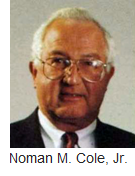
Based upon a personal visit to the South Lake Tahoe PUD AWT plant, the Chairman of the Virginia State Water Control Board (SWCB) (Noman M. Cole, Jr., an ex-nuclear submariner) got the Virginia SWCB to adopt a Policy for the Occoquan Reservoir Watershed (Occoquan Policy) located in Northern Virginia (NOVA). This Policy required the elimination of 11 small, underperforming secondary wastewater treatment plants that were degrading the water quality of the Occoquan Reservoir and replaced them with a high-performance, planned, indirect reuse regional AWT plant. It was to be designed to incorporate the same South Lake Tahoe PUD AWT Plant technologies but with additional mechanical, electrical, and operational redundant safeguards and under the purview of the same engineering firm that designed the South Lake Tahoe PUD AWT Plant: CH2M HILL.
The Occoquan Policy also required the creation of an Authority to implement the Policy and the establishment of an independent laboratory to monitor the new discharge impacts of the regional plant on the drinking water quality of the reservoir. Thus, the firm’s first and longest-term East Coast client, the Upper Occoquan Service Authority (UOSA), was born. To be selected to do the actual design (and not just the design review), the UOSA Board of Directors required that CH2M HILL establish an office in Northern Virginia, within the boundary of anyone of the Authority’s four member jurisdictions, to implement the work.
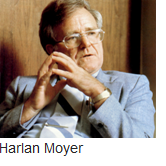
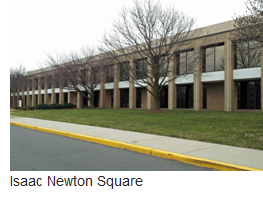
Upon being selected by UOSA in July 1971, UOSA Project Director Harlan Moyer, with the help of Gene Suhr and Sid Lasswell, set about to find a suitable location for a NOVA CH2M HILL office. All three were intrigued with the idea of locating the office in a planned community because we listed ourselves at the time as Engineers, Planners, Economists, and Scientists. Thus, the end result was to locate the office in Reston, Virginia (a totally planned community), 25 miles northwest of Washington, D.C. and in the top floor of a two-story office building located in an office park called Isaac Newton Square. The office was given the WDC identifier but, in fact, was never located in Washington, D.C. and was called the “Reston Office.” In actuality, the office was much closer to Dulles International Airport (IAD); but in 1971, that airport identifier didn’t have a significant regional connotation as it does today. On the not-so-positive side and not widely known to the office park residents, there was also an animal laboratory operation in an adjacent building within the office park. The laboratory conducted research with monkeys on the highly deadly “Ebola” virus, which, if accidently released, would have wiped out most people residing in Northern Virginia at the time. So much for “knowing thy neighbor.”
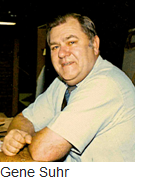
In addition to the work for UOSA, CH2M HILL was also selected a year later to design another completely new green field AWT plant for the Washington Suburban Sanitary Commission (WSSC) to be located in western Montgomery County, Maryland. With these two major projects, the Reston Office had a great workload base from which to grow. Gordon Culp, who also worked on the South Lake Tahoe AWT Plant project, was named the WDC office’s first Regional Office Manager in 1972. In 1974, Gordon left CH2M HILL to start his own engineering consulting company (CWC); and Gene Suhr ultimately took over the as the WDC Regional Office Manager. During this Discipline 70s time period, many of the firm’s leaders and future leaders contributed to both delivering these two major projects and helping to grow the firm’s Mid-Atlantic business. These leaders included Harlan Moyer, Gene Suhr, Sid Lasswell, John Filbert, Don Evans, Bob Chapman, Howard Wilson, Ray Prettyman, Dana Rippon, Dick Ivey, Bill Waters, George Fisher, and Dave Evans, just to name a few.
In the mid-1970s, the staff growth of the WDC Isaac Newton Square Reston office could be measured by the changes in the carpet color as you looked down the second floor main hallway within the office. Gene Suhr’s office and hallway had a particularly ugly orange shag carpet.
During the 1970s, the geographic range of our services also grew as well into Maine, Pennsylvania, Maryland, and South Carolina. The acquisition of BC&E in the late 1970s and RGH in the early 1980s also greatly expanded our business base into the Northeast. By the end of the 1970s, the growth of the WDC Office exceeded our capacity to expand any further at the Isaac Newton Square location. Key staff working out of the WDC office at that time were George Gunn, Glenn Rehberger, Jim Howey, Brent Bixler, Al Wollmann, Dave Ellison, Ed Prestemon, Frank Gray, Luigi Grande, Casey Combs, and Pat Hettich, to name a few. In 1978, with Gene Suhr’s departure back to the Corvallis, Oregon, office, George Gunn assumed the role of Mid-Atlantic Region (MAR) Regional Office Manager.
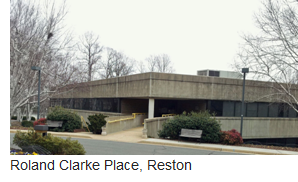
With George Gunn as Regional Office Manager, a new office location was selected in Reston on Roland Clarke Place. In the early 1980s, a two-story building constructed with the then-current +/- 60 WDC office staff at the time occupying the upper floor of the building. The building was designed to ultimately hold a staff of approximately 120 people, considered to be the ideal size for a regional “full-service” engineering firm. However, in the early 1980s, the federal government (EPA) established a new hazardous waste remediation initiative called the “Superfund Program.” Our firm’s success in managing elements of this program for EPA soon filled the Roland Clarke Place building as well as required the firm to take on additional office space across the street in the Arthur Anderson building. It thus became evident in 1984 that a larger office space would be required to effectively meet our staff growth needs as well as consolidate our business operations under one roof. During this company business growth expansion into the hazardous-waste business, staff was imported from our Northwest operations to help manage the business. Staff included Ralph Peterson, Lyle Hassebroek, Bob Card, Nancy Tuor, Bill Dehn, Wayne Sellman, and Kent Robinson, among others.
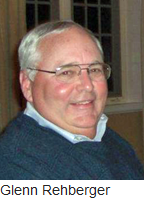
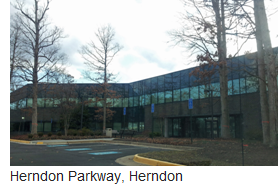
Having outgrown our office space on Roland Clarke Place in Reston, the WDC office in 1985 moved to a larger, two-story office building at 625 Herndon Parkway in the incorporated Town of Herndon, Virginia, which is located adjacent to Reston. Our staff had grown attached to our being in Reston and thus the move to Herndon was with some mixed emotions. At this point, all our business groups were growing. The demands for the WDC office (now the Herndon office) to support our growing Northeast area offices located in Rochester, NY; Philadelphia, PA; Boston, MA; Pittsburgh, PA; and Parsippany, NJ; was in full bloom. About the same time we decided to move the Reston Office to Herndon, we also made the decision to open an area office in Newport News, VA; and Glenn Rehberger agreed to move there and manage the area office. Over the past 25+ years, Glenn has been extremely successful in expanding our water business in the Hampton Roads area of Virginia.
As our Northeast business continued to grow, so did our need for more space. Thus, in 1998, the office again moved. This move was to a much larger six-story office building (13921 Park Center Road), adjacent to Route 28 and Dulles International Airport. This was still in the Town of Herndon, VA, where we occupied the top two floors in the building with even more space to expand should we need it. “Home at Last.” As circumstance would have it, when it came time to renew our lease for the Park Center Road building in 2006, an agreement could not be reached. Thus, the WDC Herndon office was required to move to its current location at 15010 Conference Center Drive, Chantilly, VA, in an office park building complex called Westfields.
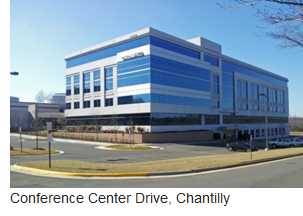
In addition to the growth of the WDC office itself, the company’s presence in the Washington, D.C. area also continued to expand. We now have offices and staff in Silver Spring, MD; Baltimore, MD; Arlington, VA; and the District of Columbia. In addition to our expanded Metro Washington, D.C. geographic presence, the business groups and skills they bring to the market are also well represented. The portfolio of WDC office clients we serve and projects we deliver span almost every business group and project type. In addition, to better serve our “firmwide” clients, we also have a very skilled and valuable government affairs office in Washington, D.C. that was started by Dick Corrigan in 1981 and is now currently lead by Howlie Davis.
Over its 41-year history, the WDC office has grown from 1 person to over 350 and become CH2M HILL’s flagship Mid-Atlantic and Northeast business group project delivery support office. There are just too many people and great clients to thank for the success of the WDC office. The following is a listing of WDC Regional Office Managers: Gordon Culp, Larry Costello, Gene Suhr, George Gunn, Bud Ahearn, Bob Chapman, Dick Bedard, and Liliana Maldonado. We firmly believe that no one single other office in the company has had the impact that the WDC office has had on the long-term business growth of this firm. None of all this business group growth would have been possible without the vision and strength of commitment of the firm’s founding fathers, Jim Howland and Holly Cornell, to build a “national” vs “NW regional” environmental engineering company and a very special NOVA client who we have continually served for the past 42 years, named “UOSA.”
Affiliates/Subsidiaries
AmTest Inc.
(A Canadian Corporation)
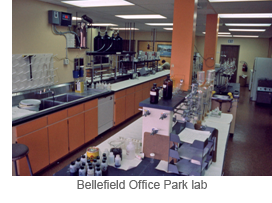
AmTest Inc. is a full service analytical laboratory that offers a myriad of testing services in the environmental, food, industrial and biological fields. The laboratory has been in existence since 1977 and in its current facility (Kirkland, WA) since 2008.
AmTest Inc. is a privately held Washington corporation and fulfills the criteria of a Small Business Concern. AmTest Inc. is also a Woman-owned business with 51% ownership belonging to its President Kathleen Fugiel and 49% to its Vice President Aaron Young.
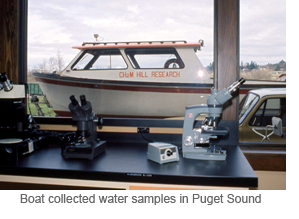
The laboratory originated as an in-house facility owned by CH2M Hill Inc. It was located in Bellevue, Washington and had a staff of four. Analytical services were provided to their own engineering group with only a few outside clients. In 1977, a 55% interest in the laboratory was purchased by Can Test Ltd. in Vancouver, Canada and the name was changed to AmTest Inc.
The laboratory grew to a staff of seven over two years and at that time AmTest Inc. bought out a small laboratory in Ballard, Washington (Food Chemical and Research) and the two laboratories were combined into the Food-Chem building. The laboratory grew quickly and by 1985 there were seventeen employees and a severe shortage of space. In 1986, the laboratory operation was moved to Redmond, Washington and a new 13,000 square foot laboratory was designed specifically for a diversified and safe working environment. In 1999, majority ownership was sold to Kathleen Fugiel when Can-Am laboratory group sold all of its American holdings. In 2008, AmTest purchased a building in Kirkland Washington where it currently resides. The space was renovated and redesigned for the current AmTest needs.
View the AmTest marketing brochure. (PDF)
Contributed by Constantin Zadorojny, November, 2010
CH2M Industries
As recalled by Mike Fisher
CH2M Industries was originally a company called Subsurface Explorations Company (SUBSECO). It was formed very early on for liability protection purposes associated with doing soil testing. It had become dormant and the name was changed in the late 60s and used to house innovations created by members of the CH2M organization. This company served to build, market, and service these innovations. To our knowledge, these innovations were never patented. Among such items were:
Sewer Sampler: A mechanism which permitted the automatic periodic sampling of the effluent being processed so that the treatment process could be efficiently monitored. Gene Suhr was the inventor of this system.
Aircraft Landing/Takeoff Counting Device: Invented by Dick Rawlings/LAO.
Smith Slope Meter: The Smith Slope Meter is a device that, when inserted in any underground conduit, measures the slope (rise over run) of the conduit at the spot in the conduit at which the meter is located. Slope information is relayed back to the operator on the surface above the conduit being tested. Harlan Smith was the inventor.
We need your help in gathering information regarding this topic. If you can provide any data which describes the background and overall impact of this segment of CH2M HILL’s history, please contact us.
Every such contribution, no matter how sparse it may be, would help in the successful completion of the saga of CH2M HILL. Thank you for taking the time to lend a hand.
CONSUD
(Consultores Sudo Americanas)
CONSUD was the acronym by which a joint venture, formed with an individual named Henry Arntsen, to perform multi-discipline projects in Argentina, was known. The concept behind the organization was that local nationals would be hired to actually perform the services while CH2M provided technical expertise.
Initially, CH2M viewed the pursuit of such work as an opportunity and over time, some studies were completed under the CONSUD name, but no projects were actually completed. Eventually, the business arrangements with the Argentinians were dissolved and CH2M came away from its first venture in overseas work richer only in experience.
The General Services Company (aka Corporation)
The General Services Company was a company formed in the early 60s with the intent that it serve as a separate organization to build, market and service the newly patented equipment created by members of the CH2M organization. Among such items were:
Flomatcher: A variable speed pump control invented by Burke Hayes which permitted the automation of the pumping system in a Water Treatment Plant.
Microfloc: A system utilizing an extremely fine filtering system which when properly incorporated into a Water Treatment System could create near drinking-water quality effluent. This process was invented by Archie Rice.
The General Services Company operated out of a separate building near the CH2M offices primarily under the supervision of Archie Rice. A number of the various units were manufactured and sold or installed but it was ultimately decided that the ownership of these systems was causing apparent conflicts of interest when they were proposed as part of projects during negotiation. To eliminate the appearance of a conflict of interest, a sale of the General Services Company (GSC) was negotiated with the Neptune Meter Corporation in 1963 or 1964. As part of the negotiated sale, Archie was to remain with GSC and serve as its president for 5 years, after which he was able to return to CH2M. During his service with GSC, however, Archie remained on the board of CH2M and continued to provide his unique and able strengths and abilities wherever they were needed.
The birth of tube and plate settlers Concept to reality, 1909 – 1965: In December 2014, Gordon Culp, formerly a CH2M HILL and Neptune Microfloc staff member, published a paper titled “The birth of tube and plate settlers: Concept to reality, 1909 – 1965, in the December, 2014 issue of the AWWA Journal. On page 40, under the heading of “MOVING FROM CONCEPT TO REALITY: 1965”, the article sheds additional important historical information about Archie Rice and MicroFloc.
We need your help in gathering information regarding this topic. If you can provide any data which describes the background and overall impact of this segment of CH2M HILL’s history, please contact us.
Every such contribution, no matter how sparse it may be, would help in the successful completion of the saga of CH2M HILL. Thank you for taking the time to lend a hand.
Gore & Storrie
(A Canadian Company)
CH2M HILL’s Canadian Engineering company, CH2M HILL Engineering, Ltd. (CHEL) merged with Toronto-based Gore & Storrie in September, 1995 to form CH2M Gore & Storrie, Ltd. (CG&S). CG&S employed more than 450 professionals and is the largest water/environment firm in Canada.
Prior to the merger, Gore & Storrie was Canada’s largest environmental engineering firm, specializing in the water/wastewater and environmental markets. The highly respected firm was an employee-owned company that had operated in Canada since 1919, and had built an organization of offices in eight cities across Eastern Canada. It had been a recognized leader in the environmental field and has been honored on several occasions with the Schreyer Award, the highest recognition for engineering excellence in Canada. In 1991, Gore and Storrie won a major Award of Excellence for an ingenious sludge dewatering, transportation, and incineration upgrade at the Metropolitan Toronto’s Main Treatment Plant. Other notable award-winning projects were the Lorne Park, North America’s first major underground water purification plant with parkland on top, and a closed-loop sludge destruction system with energy recovery that eliminates the need for supplementary fuels at the Lakeview Pollution Control Plant in Mississauga or what was then known as West Toronto Township.
In addition to William Gore and William Storrie, one of the original founders of CG&S was the well known and highly respected bacteriologist and public health specialist of that period, Dr. George Nasmith, together forming the partnership known as Gore, Nasmith & Storrie. Dr. Nasmith brought to the tiny firm the expertise that would be required for dealing with the environmental issues that face society today. When this partnership was formed in 1919, the company was a pioneer in the consulting engineering profession, since at the time the whole of Canada boasted only twenty other consulting engineering firms. Thanks to its early and distinctive specialization, Gore and Storrie Limited (as the firm became named upon its incorporation in 1954) became Canada’s largest consulting engineering firm practicing exclusively in the environmental field.
Because of Gore and Storrie’s stellar reputation and its history of notable accomplishments, CH2M HILL was fortunate to be able to acquire it when it became available in the early 1990s. The union enhanced the service network and expanded the technical resources of the CH2M HILL organization but more importantly it served to “enrich the reservoir of insights and perspectives we can share with our clients” according to the CEO of CH2M HILL, Ralph Peterson.
IDC(Industrial Design Corporation)
IDC, also known as Industrial and Advanced Technology (I&AT), is a full-service design and construction management firm serving high-technology industries worldwide including microelectronics, biotechnology, pharmaceutical and food processing. IDC provides a full range of facility design, construction, operations, and facility maintenance services. Incorporated in 1985 as a subsidiary of CH2M HILL Companies, Ltd., IDC has a staff of more than 1,300 professionals located in fourteen offices throughout the US, as well as in Asia, Europe, and the Mideast. It specializes in advanced systems for high-technology facilities, such as systems for cleanrooms, ultrapure water and wastewater, production tools and automated material handling systems. IDC has designed more than five million feet of cleanroom space, including many of the world’s most advanced cleanroom facilities. It is also a leader in cost modeling for industrial facilities, to help clients optimize production performance and return on investment.
As an original startup company with a staff of 37, IDC has grown to become an internationally recognized leader in the design, construction, maintenance and operation of high-technology facilities. (View the I&AT Historical Timeline.)
(PPT) IDC is a true full-service firm with proven capability in all aspects of facility design, construction, operations, and facility maintenance. Its technological leadership and versatility are major factors in the reason that 80% of IDC’s work comes from repeat clients. This workload could include both large and small projects, ranging from minor maintenance efforts to major retrofits. IDC is able to consistently deliver cost-effective service on projects of any scale because of its flexibility of the project management approach and the exceptionally broad experience of its staff.
The Evolution of IDC’s Technology Leadership
IDC’s heritage as a technology innovator and proven problem-solver began in the early days of microelectronics manufacturing in the 1980s. During the approximate period of 1975-1985, high-technology facilities were designed using a traditional approach, an approach led by architects performing facility design who were supported by scientists who provided guidance for the design of the specialized systems needed to support the operation of such facilities. CH2M HILL was one such company offering this kind of scientific consultation.
As the complexity of microelectronics facilities increased, the constructors required more advanced design technology. During the mid-1980s, engineering began to take precedence over architecture as the dominant designing force for these facilities. That’s when IDC was created. IDC led a trend to fully integrate a complete range of engineering services (mechanical, electrical, civil, structural) with architectural and construction management expertise. This consolidation of facility design and construction services from a single source relieved owners of the burden of assembling and managing the many disparate components of a project team assigned to produce an extremely complex facility within the limitations of a cost-effective budget. As the microelectronics industry matured during the 1980s, IDC continued to add even more services to complement the facility design and construction process. It was during this time that IDC gained prominent recognition for its cleanroom design expertise. By the late 1980s, IDC had designed a number of cutting-edge Class 1 cleanrooms, defined as having no more than one microscopic particle per cubic foot of air.
In 1988 a consortium of leading US microelectronics manufacturers combined forces to counter the threat being mounted by Japanese competitors through a sharing of technologies and resources in the SEMATECH research facility in Austin, Texas. IDC provided design and construction management services for that landmark project, and has performed a series of additional projects for SEMATECH since then. It has continued to be a key contributor to the advanced microelectronics research being performed by SEMATECH.
In the early 1990s, as the industry packed more performance capability into microelectronics components, the tools that produced those components represented increasingly greater cost and complexity. Once again, IDC led the industry trend to put a greater focus on the integration of production tools and processes into facility design and construction strategies. IDC’s Equipment Installation Services team performed design and installation services for thousands of these tools and the equipment supporting the tools.
During this era, IDC’s Technology group pioneered new approaches to cost modeling for the design, construction and operation of high-technology facilities. IDC was a leading contributor to SEMATECH’s “Factory of the Future” project in 1993 which developed the industry’s most advanced cost modeling technology. An important IDC advantage was its ability to transition cost modeling from the realm of the theoretical to the realistic by building models using data documented from years of hands-on experience with similar operating facilities.
As the 1990s progressed and costs for facility construction and operation grew tremendously, industrial owners worldwide began seeking new ways to reduce costs and increase productivity. One approach has been global consolidation among industry leaders, which have formed joint ventures to share growing costs and technologies. IDC has responded to this trend by following key clients anywhere in the world they wished to go, and finding ways to effectively meet their needs for high-technology excellence in some of the most “low-technology” environments. IDC has built strong, long-lasting relationships with a number of major industry leaders by repeatedly proving to them that it can meet or exceed their expectations under the most demanding challenges related to cost, location, and technology.
Over the years, IDC has evolved from a company specializing in multiple components of industrial facility design into a resource that can be relied on for a range of advanced strategies to improve overall facility operations, and to find new ways to reduce operating costs, minimize risks and improve a facility owner’s overall return on investment. It energetically looks forward to its commitments to technology leadership, and adapting its services to meet changing client needs as the industry faces a new set of approaching challenges.
While it is still a young firm, IDC is a truly dynamic part of CH2M HILL and its growth and development through the brief years of its existence constitute a fascinating history by itself. While such a historical record is outside the scope of this History, perhaps it will be written and made available at another time. Until then, a few additional facts and bits of information are available to give the world a better perspective on its glowing past.
IDC Legal Entities and Subsidiaries
IDC has different legal designations and affiliate companies in some locations in which we do business. These include:
IDC;
IDC Architects;
IDC Construction;
CM Inc.;
Ishimoto America;
IDC Japan (our Japan affiliates);
IDC Asia PTE Ltd. (Singapore);
IDC Asia Sdn Bhd (Malaysia);
IDC Sarl (France);
IDC Ireland;
IDC UK (Scotland);
IDC Systems Inc.(software products and services);
Wright Williams & Kelly (WWK);
Paragon Structural Design Inc.;
Facilities West (sustaining industrial facility services);
Technology Facilities Systems (high-technology products).
Acquisition of Wright Williams & Kelly (WWK)
WWK is a 7-person IDC subsidiary based in Dublin, California that provides productivity measurement and enhancement software products and services. The company develops and markets proprietary software products and is a leading expert and worldwide consultant for operational modeling programs (cost of ownership, capacity analysis, factory level costs, work in progress, and cycle time) for the semiconductor and other capital intensive industries. WWK also provides strategic and market based consulting services to technology-driven and technology-dependent organizations. Founded in 1991, WWK was acquired by IDC in January 1995.
Acquisition of Paragon Structural Design, Inc.
Paragon,a 35-year-old structural design company of more than 35 employees was acquired by IDC in 1994. Paragon, based in Phoenix, Arizona, had an impressive project record including a number of substantial commercial and civic projects in Western U.S. urban centers. Its technical expertise and highly experienced staff offered a means of gaining much desired advanced structural design technology and support for IDC’s high-technology projects around the world.
Acquisition of Walker Engineering
In 1992, IDC acquired Walker Engineering, an Idaho Company with special expertise in the food industry. This permitted IDC to seek out larger and more complex projects in a field which was only beginning to embrace higher levels of technology in order to continue to prosper.
IOTECH
(An Experiment in Radiation)
IOTECH was a subsidiary company of CH2M HILL INC. created to provide a commercial entry in the product irradiation field. Its initial target was to sanitize packaged medical products, with food products as a targeted process in the future.
The process utilized by IOTECH involved the use of Cesium-137 which was stored in canisters. A great deal of money was invested in IOTECH on the strength of what was known about irradiation technology at that time. Unfortunately, canisters holding the critical component Cesium-137 had been found leaking in other user facilities and the U. S. Government stepped in to stop all operations using these canisters in their processing. This dealt a death blow to the IOTECH operation and it was forced to cease functioning.
We need your help in gathering information regarding this topic. If you can provide any data which describes the background and overall impact of this segment of CH2M HILL’s history, please contact the Webmaster through the “SUBMIT” function which can be found in the Menu displayed at the bottom of each page.
Every such contribution, no matter how sparse it may be, would help in the successful completion of the saga of CH2M HILL. Thank you for taking the time to lend a hand.
OMI
(A CH2M HILL subsidiary)
Prepared by Kent Robinson and John Filbert
OMI’s Origins and First Four Years of Operation
The late 1970s and 1980s saw significant expansion to CH2M HILL’s water/wastewater market. That expansion was in both geographical and service areas—really a continuation of CH2M HILL’s traditional pioneering spirit.
From as early as 1977, Bob Chapman, then Redding Water/Wastewater Division Manager, had tried to compete for the then just-emerging wastewater treatment plant contract operations market. These were still small projects, but Bob sought to compete anyway. The first proposals found our price way out of competitive range. In looking at our proposals vs. the winning proposals, we determined that we just could not compete when carrying the firmwide overhead (at that time still probably 140 percent or more). And, that since this was a different business, we should not have to carry that overhead. In 1978, Bob brought his frustrations to John Filbert, then Wastewater Treatment Discipline Group Director. John led in producing an in-house study that proposed to Gene Suhr (Water/Wastewater Discipline Director), Sid Lasswell (Technology Director), and Harlan Moyer (CEO) that we establish a separate operations and maintenance (O&M) company for the purpose of competing in this market.
The company leadership, particularly those mentioned above, was very interested in the idea; however, it was not without controversy. The main concern was that CH2M HILL’s entry into such an endeavor would put us in internal conflict between “professional engineering” and “blue-collar” businesses. This brought up a then-continuing concern about conflicts between the marketing of these different services to the same client and the possibility of organized labor getting a foothold within the organization, along with numerous other issues that we did not have ready answers to.
As a result, leadership decided that the further development of the O&M organization be given further detailed and unbiased study before implementation. About the time this decision was taken, CH2M HILL was just beginning discussions with Dr. Kent Robinson (co-inventor of the high-purity oxygen activated sludge wastewater treatment process) about his leaving Union Carbide for a career in CH2M HILL. We had not come up with an initial assignment to justify his being brought on board at that time, until someone suggested that Kent be the one to undertake the study!
Before joining CH2M HILL in June 1979, Kent Robinson spent his last 5 years in Europe with Union Carbide Europe, S.A. A business that he was responsible for was the UNOX System, a wastewater secondary treatment process. This led to frequent contact with the French water and wastewater contractors, Degremont (now Suez Lyonnaise des Eau) and O.D.A. (later Societe General des Eau, now Vivendi). These contractors then, as now, share the French public sector water and wastewater design/build and O&M markets on a 50:50 basis.
Degremont and O.D.A. disclosed that they were very interested in entering the U.S. market to secure design/build contracts for water and wastewater facilities. However, they realized that local U.S. law did not permit this type of project delivery approach in what was then, and has been until 2000, a design/bid/build market controlled by the U.S. consulting engineers establishment. These French firms felt that the U.S. consulting engineers were vulnerable since they did not provide contract O&M services along with other consulting services. The French speculated that they might enter the U.S. water and wastewater markets via the long-term O&M services route and then convert these clients to design/build delivery.
In early 1980, Kent Robinson had furthered his independent study to the point where he recommended to CH2M HILL management that it needed to set up a contract O&M services business, if for no other reason than as a defense against the loss of existing clients to companies that might offer such services. At that time, Envirotech’s former EOS Services Group (now part of U.S. Filter) was leveraging the 1978 EPA wastewater Treatment Plant Operations Needs Survey to aggressively market wastewater O&M services to CH2M HILL clients. EOS was actually providing contract O&M service for about eight plants, mainly in California. Kent was asked to complete the market survey and prepare an initial business plan to form a CH2M HILL O&M company.
As luck would have it, this decision coincided with CH2M HILL finally realizing Bob Chapman’s initial dream and bring operations for a wastewater treatment plant in Maui, Hawaii, as a part of a broad engineering plus O&M services contract. Also at this time, CH2M HILL was selected as the preferred program manager of the Mississippi Gulf Coast Authorities major wastewater program, which was to include management, engineering, and O&M services. As a condition of the contract award, the Authority General Manager, Jackson Balch, insisted that the O&M services be provided by a separate company from the management/engineering company, but be fully owned or controlled by the management/engineering company. We had to rush OMI’s formation to obtain this strategic contract, and the Gulf Coast contract was in place actually before the OMI paperwork was completed. Sometimes, it happens that way. This coincidence was very important to the future growth of OMI because these three Gulf Coast plants plus the one Maui plant provided the basis for a “hot start” of the O&M Company that we were establishing.
At a CH2M HILL Board meeting in the fall of 1980, the proposed business plan to create an O&M company subsidiary was approved. Kent Robinson was given the task, along with Mike Fisher, to evaluate the various legal, financial, and operating issues that would be involved in a setup of the company. A key issue was finding someone who could lead it. Harlan Moyer was convinced that we did not then have a person with the needed entrepreneurial skill and concluded that we should search outside the firm. Mike Fisher was also concerned about the legal and tax issues that could result for CH2M HILL. He insisted that successful address of these issues would require the new O&M company to be set up as an arms-length subsidiary that would not use the CH2M HILL company name and would not employ any existing CH2M HILL employees. These limitations, as it later turned out, led to the formation of a company that for the first several years gained very little leverage from being a part of the CH2M HILL family of companies.
In late 1980, Kent Robinson and Mike Fisher began the tasks associated with incorporating the new O&M company (initially as a California company) and recruiting the first president to lead the operation. After a good deal of unsuccessful search, George Gunn, then the Reston Office Manager, introduced Mike Stark, then National Sales Manager for Calgon Corporation. Harlan Moyer was convinced that Mike Stark was the type of entrepreneurial leader that we needed, and he was hired to be the president of the new O&M Company. Even before Kent came on board, we had an internal “company naming contest” within the Wastewater Treatment Discipline Group. Kathy Ritter/CVO won the contest with “Operation & Maintenance, Inc” — hence the OMI origin—which didn’t change, whereas the base name under it was changed by Mike Stark and Kent Robinson to Operation Management International.
OMI, Inc. was incorporated in April 1981. The company’s formation and first Board Meeting was held on April 14, 1981, in Denver. Present were Mike Stark, Archie Rice, Harlan Moyer, Mike Fisher, Len Weber, and Kent Robinson. Mike Stark (now President of U.S. Filter) was elected as President. Archie Rice, who at the time was a retired employee of CH2M HILL, was elected as the first OMI, Inc. Chairman. At that time, OMI, although a wholly-owned subsidiary of CH2M HILL, Inc., had its own operating Board of Directors. Kingwood, Texas, was selected as OMI headquarters. Mike Stark lived in Kingwood, Texas, located near Houston and Houston Intercontinental Airport. Therefore, for lack of a better idea, offices for OMI were obtained in Kingwood where they would remain for the next 10 years.
Almost immediately, in the spring of 1981, OMI was faced with the takeover of four CH2M HILL executed O&M contracts to provide the “hot start” for the company. Therefore, setting up the company administrative systems and processes was an urgent matter. An initial equity contribution of $300,000 was made by CH2M HILL, Inc. to get things going. And Mike Stump, then Treasurer of CH2M HILL, Inc., was given the job of setting up accounting and other administrative processes and systems.
New employees were added swiftly led by the hiring of Bernie Miller, now COO of OMI, to manage the first OMI project for Maui, Hawaii. Bernie was employee number 3 after Mike Stark and an administrative assistant. Almost simultaneously, three new OMI contracts were added for the Mississippi Gulf Coast Authority by transfer from the old CH2M HILL Montgomery Region. The result was that OMI was well underway as a profitable operation by the summer of 1981, only a few months after its formation. Aside from the initial $300,000 equity contribution from the parent, CH2M HILL, Inc., OMI never again required any further equity investment. This was a result of innovative contracting processes that OMI adopted. These required that clients pay monthly in advance for manpower, chemicals, materials, and utility costs. This approach left OMI in a strong cash flow position from the very first year.
In late 1981, OMI undertook a very aggressive marketing campaign, including national advertising. This campaign, led by a New York public relations firm, led to many amusing incidents. For example, in early 1982, OMI held a press conference in New York City to announce the company and get some traction in trade press. At the time, the CH2M HILL policy was to give as little publicity as possible to the relationship of OMI to CH2M HILL. While Mike Stark and others from OMI conducted the press conference (at the Club 21 to attract press representative attendance), Kent Robinson had to attend incognito. He carried press credentials for “The Tie Line” of Corvallis, Oregon. “The Tie Line” was the name of the CH2M HILL company newsletter at the time!
The publicity that OMI received in 1982 led to an avalanche of inquiries and requests for proposals, far beyond the new company’s ability to respond. New contracts were added in 1982, but considerable stress was placed on the new organization to successfully operate the facilities under contract while at the same time starting up new ones. OMI quality programs, in the sense of those that enabled OMI to win the Baldridge Award in 2000, were unknown. Nonetheless, the company’s annual gross revenues grew to about $6 million.
Late that year (1982), OMI was contacted by the Envirotech Operating Services (EOS), then for sale. After much negotiation, it was decided that the $5 million price tag was not justified by the EOS annual gross revenues of $12 million. This is of interest since EOS, now a part of U.S. Filter, later sold for $60 million.
In October 1983, OMI’s first president, Mike Stark, was hired away by a firm in an unrelated business. Harlan Moyer selected Mike Stump, CH2M HILL’s Treasurer, to be the new OMI president. Mike Stump was very entrepreneurial and had been very much engaged in setting up OMI. Therefore, he was a logical choice. Mike continued the very aggressive growth of OMI, acquiring several new O&M contracts even in the face of unfavorable economic conditions sparked by the collapse of energy markets in the 1983 timeframe. At the end of 1995, OMI’s gross annual revenues had grown to $14 million; and the cash position had grown to $8 million.
In early 1986, OMI’s President, Mike Stump, was hired away to become president of Professional Services Group, another O&M services company owned by the French. At this point, Harlan Moyer appointed Don Evans, then San Francisco Regional Manager for CH2M HILL, Inc., as the third president of OMI. Don’s very successful tenure as OMI president has continued for 16 years, during which time OMI has grown to a staff of 1,300 and annual revenues of $160 million, operating more than 100 water and wastewater treatment facilities. Today, OMI holds a substantial share of the North American water and wastewater O&M market. All of its major competitors are French-owned firms.
Expansion Into Public Works
Partnering with communities to provide public works such as road maintenance, mowing, and more actually began in 1992. This was when CH2M HILL OMI added public works to its traditional services menu of operations and maintenance for water and wastewater treatment systems. Today, public works include many services such as fleet maintenance, street and signage maintenance, parks and grounds maintenance, mosquito control, solid-waste collection, traffic engineering and operations, permit processing, inspections, administrative services, and street and roadside maintenance, including snow removal.
This successful public works practice includes:
- 15+ years of delivering public works services
- 525+ employees involved in public works projects
- 150+ contract years of experience
- 6 states and 17 communities where associates manage public works; Colorado, Florida, Georgia, Louisiana, New Mexico, and Oregon
- 944 vehicles maintained at the three largest public works projects in Georgia—Hinesville, Effingham County, and Richmond Hill—including:
- 218 police vehicles
- 70 fire and emergency response vehicles
- 11 mass transit vehicles
- 645 other vehicles such as pickup trucks, city fleet automobiles, and miscellaneous motorized equipment
July 1, 2018, is a milestone for the city of Centennial, Colorado, and CH2M HILL OMI. For Centennial, it is the first day the city will have its own public works department. The contract with the 100,000-person city, which was incorporated in 2001, was the only practical approach. Until this year of 2008 when the city developed its own public works department, it relied on county services. Without a private company like OMI, it would have been difficult and costly to start new departments from scratch. Read More
OMI – Celebrating 40 Years to the same as Expansion Into Public Works.
Paragon Structural Design
Paragon Structural Design is a full-service structural engineering firm serving the architectural and construction communities since 1963 by providing complete design and construction administration services. In 1994, Paragon became a subsidiary of CH2M HILL.
At Paragon, our goal is to add to the built environment in a way that is architecturally pleasing, environmentally prudent, and serves to protect the safety and welfare of the public. We strive to work on projects that are challenging, complex and artistic because these are the qualities that stimulate us as designers. The laws of physics and mathematics are the tools we use to push the boundaries of creative structural design.
Known for our extensive experience in providing innovative and economical solutions on challenging projects, Paragon is one of the leading structural engineering organizations in the country. We are a design-oriented structural engineering group that has been practicing for more than 45 years.
Paragon specializes in facilities for civic services, healthcare, justice, education, aviation, science & technology, sports & entertainment, and commercial enterprises. Read More…
Paragon Services
- Feasibility analysis
- Structural design
- Existing facility renovation
- Structural forensic investigation
- Peer review
- Long-span design
- Tensile structures
- High-rise structural systems
- Alternative project delivery methods
- Fire-resistant structures
- Seismic analysis and design
- Architectural concrete & metals design
- Foundation design
- Value engineering
- Floor vibration analysis
- Sustainable design
- Blast-resistant physical security design
- Fast-track construction packages

Mergers/Acquisitions
Clair A. Hill & Associates
The California Company that Added the HILL to CH2M
Clair A. Hill & Associates (CAHA) was almost single-handedly put together by Clair Hill. Although Clair, a 1934 engineering graduate of Stanford University, had been a forestry student at Oregon State College (later to become OSU) for 2 years and worked in other parts of California both before and after college, he was attracted to return to the place of his roots. His mother’s family had come from Spokane to Redding by horse and wagon in 1885.
Clair opened an office in Redding in 1938 while also working as a deputy surveyor for Shasta County to make ends meet during the Depression. He reported that he had no intention of building his firm into a growing, diversified organization; he was “just making a living – I enjoyed working for myself.” In 1941 he was called to active duty in the Army and spent 5 years of WWII in the Aleutian Islands, Alaska, and the last 13 months of the war on Adak Island in the Aleutians on bomb disposal. He grew very fond of Alaska, later establishing offices in Anchorage and Juneau.
Following his Army duty, Clair returned to Redding and opened his office in a small house across the street from the county courthouse. At this time, Northern California was growing, the engineering opportunities were more promising, and he set out to upscale his organization. Early work was mostly surveying, which grew into photogrammetry, and water projects, including dams, reservoirs, and fish hatcheries.
The Hill organization compiled a formidable record of increasing responsibility as the years passed. The firm’s first big project was to provide water resources work for the Glenn-Colusa Irrigation District in 1949. At Beale AFB, north of Sacramento, the firm developed a residential area with 1,700 homes and all support services–in other words, the firm designed and oversaw construction of a small town. Major project work was conducted on the American River and for the Sacramento Utility District, Pacific Gas and Electric and the Bonneville Power Administration. Astute marketing, good talent and quality services kept Clair A. Hill & Associates growing and made it a dominant force among Northern California consulting engineers. (See Marketing Brochure)
Clair attracted capable people from the area and before long was recruiting talent from farther afield at the Western universities. By 1950 the staff consisted of three engineers, an architect, and two survey crews. Les Shoupe and Chuck Hornbeck joined the firm in 1951, Harlan Moyer in 1952, and Jack Jensen in 1953. Several of these early employees later became owners of CAHA and subsequently became Key Employees of CH2M HILL when the two firms merged in 1971. At the time of the merger with CH2M, Clair A. Hill & Associates had 150 employees in three offices providing a wide range of engineering services.
The merger with CH2M was an amalgamation of two totally different management styles–CH2M with its consensus-style partnership and Clair A. Hill & Associates with its one-man show. But the merger resulted in a single firm greater than the sum of its parts. The ties between the two firms had grown strong during a 15-year period of association in various West Coast projects. The skills of one firm dovetailed with the other, and together the firms were able to reach new heights neither could have attained individually. Proof of this was the Lake Tahoe Advanced Wastewater Treatment Facility, the first wastewater tertiary treatment system in North America.
The union began in 1956 on a housing development in Brookings, Oregon, where Clair Hill first became familiar with CH2M’s reputation for sanitary engineering. A short time later Hill called CH2M to get help with the sewage sections of a new master plan for Hill’s home town of Redding. Other projects followed as Hill found CH2M’s reputation deserving and as he needed CH2M’s water, wastewater, electrical and mechanical expertise. CH2M reciprocated by using Hill’s specialties when needed. Clair A. Hill & Associates focused primarily on surveying, photogrammetry, water resources and structural engineering, including several major bridges and highways (PDF) for public sector clients in Northern California.
With the merger with CH2M, the 61-year-old Hill got career continuity for his 150 employees and more time to devote to his personal, civic and political interests. CH2M, with a staff of more than 300 in Oregon, Washington and Idaho, got a host of top talent in new engineering markets plus offices in California and Alaska. The merger was a clear-cut win-win situation for both firms.
Editor’s note: In response to “CH2M is Over the Hill: Engineering Giant Unveils New Name, Logo” (July 2015 issue), we received a letter from Penny (Irani) Garrett and cosigned by Louise Dibble, Linda Lack, Shirley McCarthy, and Doris Powers. “We have many wonderful memories [of Clair Hill]. I am fearful that there is a possibility that what this great man did for the small town of Redding and the State of California (and whose engineering influence ultimately was felt throughout the world), may be lost by no longer being recognized by having his name be part of the Corporation…I hope that his name will never be forgotten as you continue to grow and prosper, for indeed his mighty contributions helped to make CH2M what it is today.”
We agree, and value the merger of our firms and all staff as well as our readers. Clair, his contributions, and the contributions of Clair A. Hill & Associates are well documented herein on the Alumni History website. See the attached (PDF) for the full text of the letter.
Zinder & Associates
(Contributed by Hal Mozer)
In September 1968 CH2M acquired the Seattle partnership of H. Zinder & Associates. Zinder was a firm providing consulting services in Electric Power, Electrical Design, Systems Analysis, and Economics and Financial Feasibility. All of these capabilities were added to the services of CH2M, greatly expanding the firm’s ability to serve electric utility clients, industrial clients that were significant users of electric energy, and regulatory agencies involved in electric utility regulation. Several important new clients came to CH2M as a result of the Zinder acquisition.
Five professionals, Sol Schultz, Senior Electrical Engineer and former Chief Engineer of the Bonneville Power Administration in Portland, Oregon; Herschel Jones, Economist and first Director of the firm’s Economics Discipline; Lyle Dunstan, Systems Analyst and computer applications specialist; Hal Mozer, Senior Electrical Engineer and Director of the Electric Utility Discipline for several years in the 1970s; and Al Eastorp, a Senior Electric Utility Design Engineer; a graphics designer, Maryann Nixon; and an Administrative Assistant, Sally Ruggles, came into CH2M with the Zinder organization.
Sol Schultz, Herschel Jones, Lyle Dunstan and Al Eastorp are now deceased. Hal Mozer retired in 1993, but continued to do some consulting work for CH2M HILL until 2008. Sally Ruggles retired in 2000 after 32 years with CH2M HILL in the Seattle, San Francisco, Milwaukee, Sacramento and Redding offices. Maryann Nixon left the firm in the 1970s.
Black, Crow & Eidsness
(Excerpted In Part from the “Tie Line” December 29, 1995)
Black, Crow & Eidsness (BC&E) grew out of the work of Dr. A. P. Black, head of the University of Florida Department of Chemistry in Gainesville. Dr. Black has been described as the “Fred Merryfield of the University of Florida.” He had a great rapport with his students and looked far afield from the university to provide practical knowledge for his students and practical applications for chemistry. He did consulting work and provided laboratory services, activities that grew into Black Laboratories, which he formed in 1947.
The founders of Black Laboratories were A. P. Black, his son Charles, and Bill Crow. Both Charles Black and Bill Crow had served in the European theater of operations during WWII, and returned to Gainesville to finish their engineering studies that had been interrupted by their Army service. Both worked for the City of Gainesville while completing their studies; Bill Crow in the power generating facilities, and Charles Black as chief chemist for domestic and industrial water supply.
Fred Eidsness came from work in industry in the water and wastewater fields. He held a reserve commission in the U. S. Public Health Service, and during the war years was Sanitary Emgineer for the Florida State Board of Health. He joined Black Laboratories in 1951 to found Black, Crow & Eidsness (BC&E) and also entered a doctoral program at the University of Florida. The goal of BC&E was to expand their economic base by providing a full range of engineering services to municipalities and industries. At the time of its acquisition by CH2M HILL in 1977, BC&E had grown to a 200 person water and wastewater firm with seven offices in the Southeast and regional offices in Philadelphia, Pennsylvania and Rochester, New York.
During the mid-seventies, BC&E found itself in financial difficulties and was seeking for a way to survive intact and to preserve its excellent reputation for quality work and innovative methods. It had already been acquired by the Hercules Corporation, a well known chemical and explosives manufacturing firm that had little experience in the type of engineering that BC&E was involved in. As a result, it found itself floundering to complete several major projects while suffering from severe staffing and financial problems.
Partially through the efforts of Ignacio Garcia-Bengochea and Manuel Vilaret, CH2M HILL was sought out as a possible savior of a fine establishment that was teetering on the brink of disaster. After many days of negotiations, trying to sort out potential losses from a number of major projects then under contract, an amicable agreement was reached with the Hercules organization and BC&E began its new life under the CH2M HILL banner. It took many years and a huge financial commitment on the part of CH2M HILL to restart the engine of this proud and very capable firm, but the rewards were well worth it. Staff quality at BC&E was extremely high, adding many notable figures to the combined firm. Over the years the lines that had separated the two firms gradually dimmed and the synergistic results contributed greatly to CH2M HILL’s future growth.
Watson Engineering
“Calgary, Canada has a great number of good looking logos atop its downtown towers. It announces the presence of a lead tenant, CH2M HILL, a global leader in consulting, design, design-build, operations, and program management celebrating its 35th year (2013) in this city.
The new Calgary office (1978) developed quickly and, teamed up quickly with Watson Engineering, won some relatively large heavy oil projects. A break-through was Suncor Fort Kent, which further established CH2M HILL’s credentials in water treatment and led to recycling for thermal heavy oil projects. It also laid the ground work for the acquisition of Watson Engineering in 1984.” [Excerpted by Dave Evans from a Waterton newspaper scan]
In August 2014, Ken McWhinnie, a 29-year employee of CH2M HILL, Calgary, Canada, wrote this alumni history editor, Dave Evans, the following:
“Watson engineering was the company’s first acquisition in Canada. The company was started by Tom Watson in 1979 and became part of CH2M HILL in 1984. I joined CH2M in 1985 so I knew most of the Watson people although they were so well integrated that I didn’t know they were Watson people until much later. Tom was a crusty old guy who played contact hockey into his sixties. I was a little afraid of him at first until I got used to his dry sense of humour. We became good friends. Tom’s first love was flying and he owned a Cessna that he flew out of Springbank airport in Calgary. One of the senior people who came with Watson Engineering was Rob Bridgett. He was not an engineer but he did all their costing and pipe stress analysis work. He was a really nice fellow. His passion was also flying and Tom and Rob had many adventures including flying to Ireland via Newfoundland and Iceland. Sadly this passion was their undoing. Flying home one afternoon from BC they hit bad weather and the Cessna froze. Losing control, the plane crashed into the side of a mountain. Tom and Rob were killed, as was another passenger. By this time Tom had retired and Rob had moved to another company but their loss was felt heavily by us old-timers at CH2M.”
DeMil International (2004)
Goldston Engineering, Inc.
On March 1, 2008, Goldston Engineering, Inc., a Texas-based firm with offices in Corpus Christi and Houston, joined the CH2M HILL team. Goldston is a technology-driven consulting engineering firm providing marine, coastal, municipal, and transportation engineering services. “Our standards for quality, integrity, reliability, and client service mirror those of CH2M HILL, said William F. Goldston, P.E., “and our cultures are closely aligned.”
Goldston was founded in 1949 and has provided high-quality engineering solutions to marine, bridge, and municipal engineering projects. The company’s heritage of state-of-the-art specialty services resulted in substantial opportunities for repeat business.
The Goldston Story
Goldston Engineering has been around for 60 years. It hasn’t always been an engineering company. Its rich, diversified history actually began back in the ’30s and has evolved and weathered three oil crashes that caused other firms to fold.
In 1938, the late Colonel William M. Goldston started a construction company. He and his son, James, later formed Goldston Engineering because James had noted the poor quality of construction plans, and saw an opportunity to provide a better product. His company could offer a quality design and build it.
James’s son, William, worked part time for the Goldston companies until 1971, when he graduated from Imperial College in London with a master’s degree in geotechnical engineering. He landed work as a geotechnical engineer in an 11-person firm in the U.S. and helped grow their geotechnical business. After 5 years, he decided to get a job close to home, his dad made him an offer he couldn’t refuse, and he joined the family business.
The Goldston businesses thrived with the expansion of the energy sector in the late ’60s and ’70s. At its peak, the businesses included GMG Construction (a closed-shop industrial construction company), Refinery Maintenance Co. (an open-shop industrial construction company), the marine and civil division, the building division, Goldston Shipbuilding, Inc., and Goldston Engineering, Inc., employing 1,800 people in all.
In 1978, William opened a shipyard where the firm could build its own tugboats. Soon Goldston started building tugs for others. They had built 13 vessels in 2 years when the tug-building business suddenly dried up. But they were in the midst of building a 75-foot offshore tug boat and two 160-foot supply boats. So William offered cash milestone incentives to finish the tugboats on schedule and within budget, delivered the boats, then closed up shop.
Over its history, Goldston Corp. skillfully avoided falling prey to crashes in the oil industry. In the ’50s, Goldston had 27 barges out on different projects one month; the next month, all 27 barges were tied up at the dock not making any money. In the ’60s, three major clients went bankrupt at the same time. The oil crash hit so fast that sales fell from $47 million in 1980 to $18 million the following year.
In 1981, James, William, and the chief financial officer went to the bank to let them know they had a problem, thanks to the oil crash. The bank worked with them “like you would not believe,” said William. All short-term debt was turned into long-term debt. They worked with the bank monthly, and got three loans to pay off creditors. In 1985, they settled their debt with the bank, sold all equipment at auction, and closed the doors at Goldston Corp. James and William nevertheless found the resources to help two of their construction VPs start their own firms, and both are successful businesses today.
Goldston Engineering, Inc., was a separate entity, and while it was affected by the crash of the ’80s, it kept operating, downsizing from 110 to 16 employees. Non-family members had managed this company for several years, but in 1985, James regained management responsibility and the bottom line improved immediately.
William remained in construction under the name Port Corporation, performing industrial, marine, and utility projects. But the economy was still touchy so he closed Port Corp. in ’87, realized he could only be happy in construction, and became president of the engineering company. He recognized a need to re-brand and find different work in Corpus Christi, because up until then, the Goldston companies were best known for their waterfront efforts. So they took on simple fish hatchery projects in Texas, Florida, Louisiana, and Belize. William saw the need to further diversify—both in disciplines and location. Goldston Engineering had not done infrastructure work for the City of Corpus Christi in 20 years. He developed a 3-year strategy that paid off: Goldston’s is the work standard now used by the City of Corpus Christi to choose other infrastructure consultants.
As business grew, William determined they should open a second office in Houston to take advantage of the fact that many competitors hadn’t survived the 1980 oil crash. The Houston office started with two employees, 100 percent billable on a Dow Chemical project, and grew from there.
Around 2004, Goldston recognized the need to expand into transportation through Texas Department of Transportation (TxDOT) work. Another 3-year strategy was developed that paid off and Goldston began working for TxDOT.
Over the years, several firms had approached William to buy Goldston Engineering, but he felt they didn’t fit Goldston’s culture. “We’re like family here,” he said. “My responsibility as an employer is to do my best to provide the best career opportunities to all my employees.” What he found attractive about CH2M HILL was its employee ownership. The principals’ leadership was evident, as well as the sweat equity the principals and employees put into the company. He also recognized their collaborative approaches and emphasis on safety and quality, which mirrored Goldston’s philosophy and core values. William saw the acquisition as a huge opportunity for his employees.
Before becoming part of CH2M HILL, Goldston focused on ports, infrastructure, and transportation. William recognized a bright future in land development and implemented a plan to cultivate relationships with local developers. CH2M HILL continues to nurture the relationship that Goldston started with TxDOT, and its petrochemical port work offers great opportunities to CH2M HILL’s oil and gas group.
CH2M HILL Acquires Halcrow
In one of the largest acquisitions for a U.S. firm in 2011, CH2M HILL acquired the global transportation engineering firm, Halcrow Group Ltd., for about $192 million in cash. This deal also included Halcrow’s outstanding debt and pension liability that increased the acquisition value to more than $356 million.
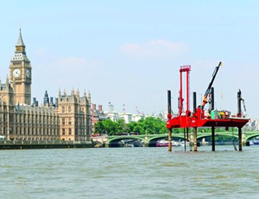
Halcrow is one of the oldest and finest engineering consultant firms in the world. It is a British-based engineering, planning and design, and managerial services firm that works on the toughest engineering projects worldwide. Halcrow employees are known for the highest quality of engineering, brilliant technology, and innovative solutions. The firm, founded in 1868, has delivered hundreds of marquee projects including High Speed 1 in the UK (also known as the Channel Tunnel Rail Link), the Chongzun Expressway in China, and Yas Island in Abu Dhabi. Since 2008, Halcrow has been working with CH2M HILL on the Thames Tideway Project; CH2M HILL is the program manager and Halcrow is a project subcontractor. Halcrow is also a key designer for the UK Crossrail program, a project that CH2M HILL is separately involved in.
Bringing together these two great engineering firms is a step change towards achieving the CH2M HILL Strategy 2015 objective of disciplined growth in priority geographies and markets. It gives CH2M HILL the scale and scope to become a more competitive force in the global marketplace.
Halcrow has over 6,000 employees. This brings the CH2M HILL staff size to almost 30,000 with around 11,000 employees outside the U.S. Halcrow has 80 offices in 70 countries.
Halcrow reported 2010 revenue of about $719 million. It was ranked 52nd on ENR’s list of the Top 150 Design Firms, with about 61 percent of 2010 revenue in transportation work. CH2M HILL was the industry’s 5th largest global, with $3.6 billion in 2010 worldwide revenue, about $891 million outside the U.S., and about 17 percent in transportation work.
Jacque Rast will head up the newly merged firm’s operations outside the U.S. from London. She is currently president of CH2M HILL’s facilities and infrastructure division. Jacque says that this merger is a “perfect fit” because these two firms have worked together on projects for about a decade and Halcrow will enhance the firm’s skills in the key markets of water, transportation, facilities, environment, and energy. She added that the merger aimed to meet the demands of clients who increasingly wanted a wide range of services delivered by a trusted firm with bases throughout the world. This merger will catapult CH2M HILL into the top 10 consultants in the United Kingdom. Halcrow has a strong geographic footprint with exposure to high-growth emerging markets in South America, Asia Pacific, and the Middle East.
For the near future, Halcrow will be referred to as “Halcrow, a CH2M HILL company.”
Photo courtesy of Thames Water – CH2M HILL and Halcrow are prime contractor and sub, respectively, on the multi-billion dollar Thames combined sewer tunneling project in London.
CH2M HILL Finalizes Acquisition of the Business of TERA Environmental Consultants
CH2M HILL has entered into an agreement to purchase the business of TERA Environmental Consultants. The transaction is expected to close in the second quarter of 2014.
Based in Calgary, TERA has two other offices in Alberta and one in Victoria, BC. With a staff of over 450, TERA has been in the environmental consulting business serving the pipeline, electrical transmission, and oil and gas industries for more than 30 years.
CH2M HILL Chief Executive Officer Jacqueline Hinman said, “TERA’s team has built a tremendous business that we are excited to welcome to the CH2M HILL family. Cultural fit was a deciding factor for both CH2M HILL and TERA when considering this opportunity. TERA has a well-regarded reputation for teamwork, providing excellent client service and being an employee-centered company, which meshes well with CH2M HILL’s culture.”
TERA focuses on providing environmental consulting services to the Canadian pipeline, power line, and oil and gas industries. TERA’s staff is anchored by its group of professional environmental planners who provide project leadership in managing the various regulatory processes. This core group is complemented by TERA’s specialized disciplines, which include Aquatics; Wetlands; Vegetation; Wildlife; Remediation, Reclamation, and Restoration Planning; Socio-Economics; Stakeholder Engagement; GIS; Archaeology; Traditional Ecological Knowledge; and Traditional Land Use.
Chris Shea, president of CH2M HILL’s Environment and Nuclear Market, said, “The Canadian energy industry has great need for the services TERA offers. Siting, licensing, permitting, and environmental planning are necessary for all facets of energy production, whether it’s for pipelines, transmission lines, power plants, or roads and utilities to production areas. We see a lot of potential for growth in the market and look forward to helping bring TERA’s excellent service to more clients across the country.”
Tom Searle, CH2M HILL’s Regional Managing Director in Canada, said, “Growth in Canada and offering our clients the full spectrum of environmental services have been a top priority in ensuring our competitiveness and sustainability.”
Piers Fothergill, President of TERA, said, “When we went looking for an industry partner that could help us harness and capitalize on our growth, it was paramount that we find a company that fit with who we are and who we want to be. The benefit of going with a larger company like CH2M HILL is that they bring the systems and tools to facilitate the growth of our business. I’m excited by the prospect of serving more clients across Canada and for the career development opportunities our people will have with a global environmental firm.”

